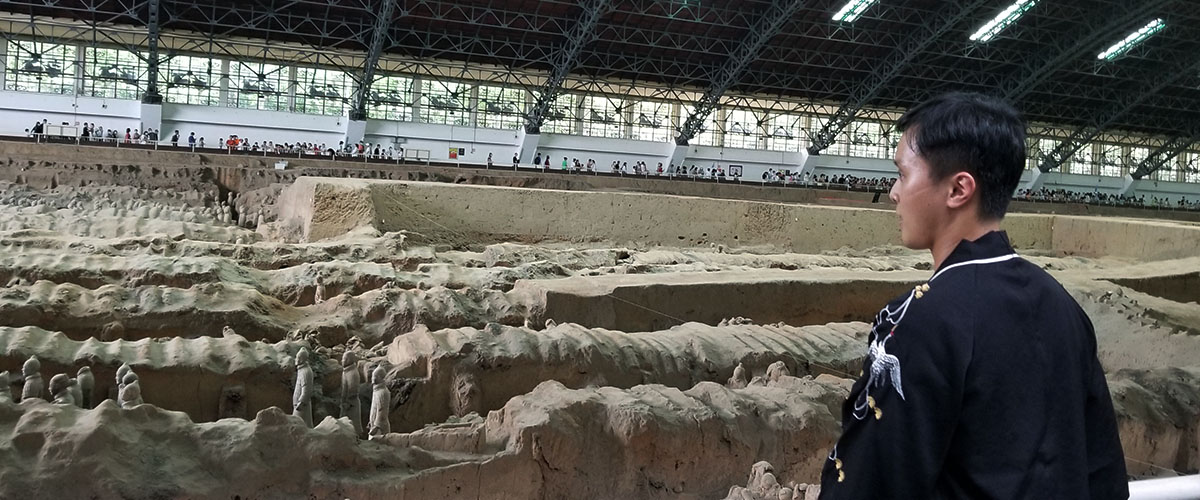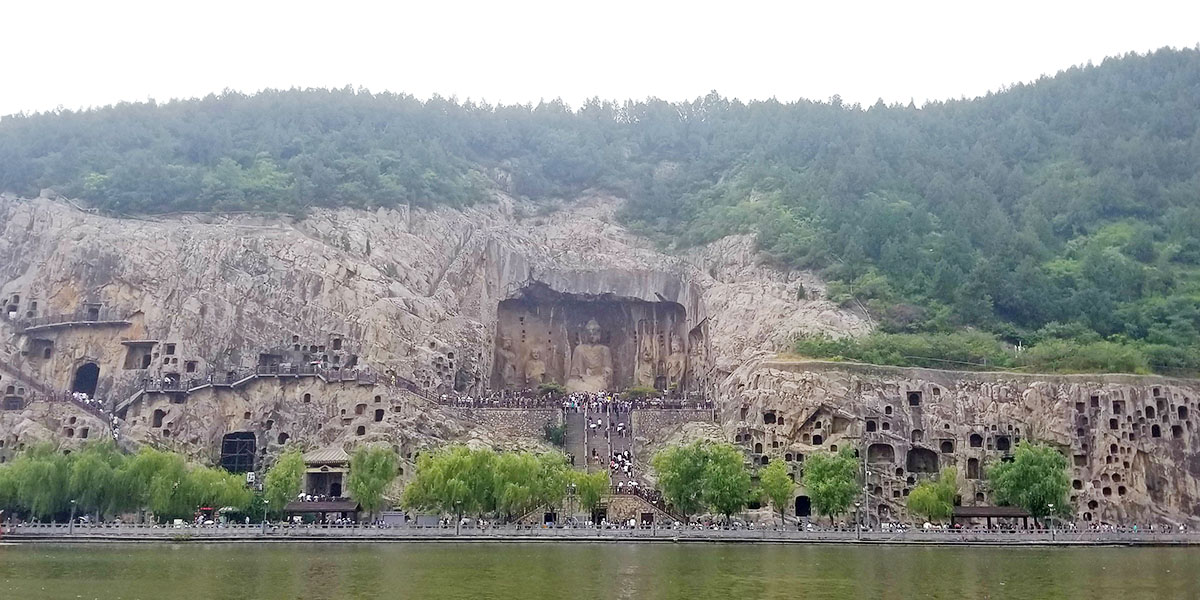|
China - Xi'an & Henan |
|
In June 2021, I was sent to Zhengzhou, Henan Province, for an IPO
project and had the opportunities to travel Central China after 21 days
of quarantine. I've always wanted to visit Xi'an, as it was the root of
Chinese civilization. So here I was finally exploring various sites of the ancient city
of Xi'an and other areas of Central China, which almost all of them are
listed under UNESCO. Xi'an, Shaanxi Province (陕西省西安市)
|
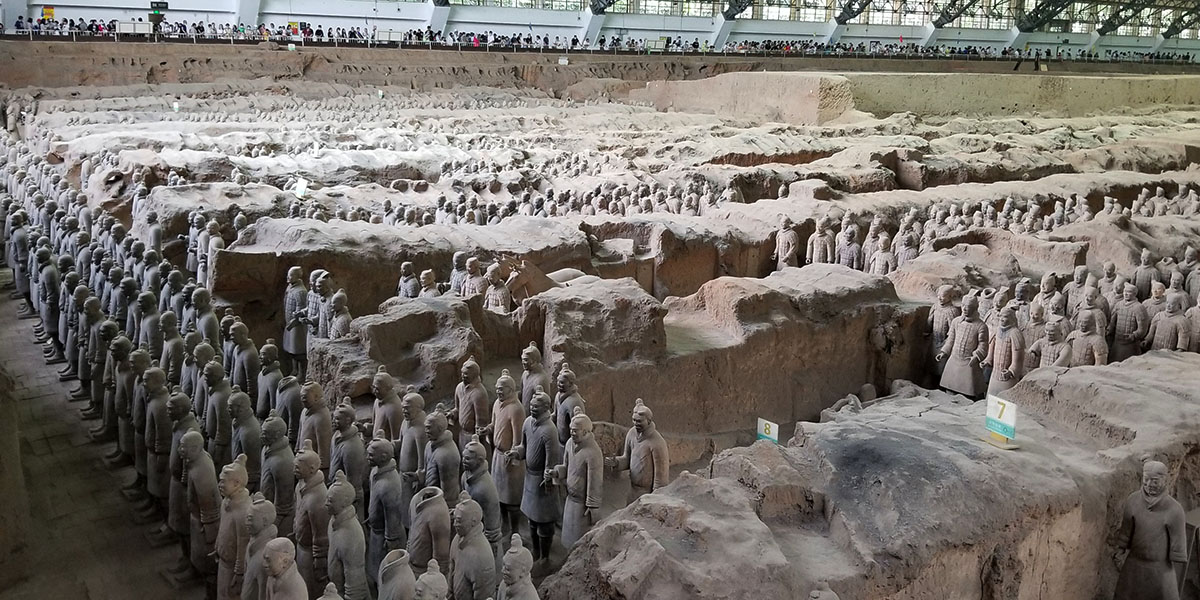 Archaeologists estimated there are over 400 pits, yet 4 main pits approximately 7 metres (23 ft) deep have been excavated and opened to public. This Pit 1, 230m x 62m, contains more than 6,000 army figures. Pit 1 has eleven corridors, most more than 3 metres wide and paved with small bricks with a wooden ceiling supported by large beams and posts. This design was also used for the tombs of nobles and would have resembled palace hallways when built. The wooden ceilings were covered with reed mats and layers of clay for waterproofing, and then mounded with more soil raising them about 2 to 3 metres above the surrounding ground level when completed. |
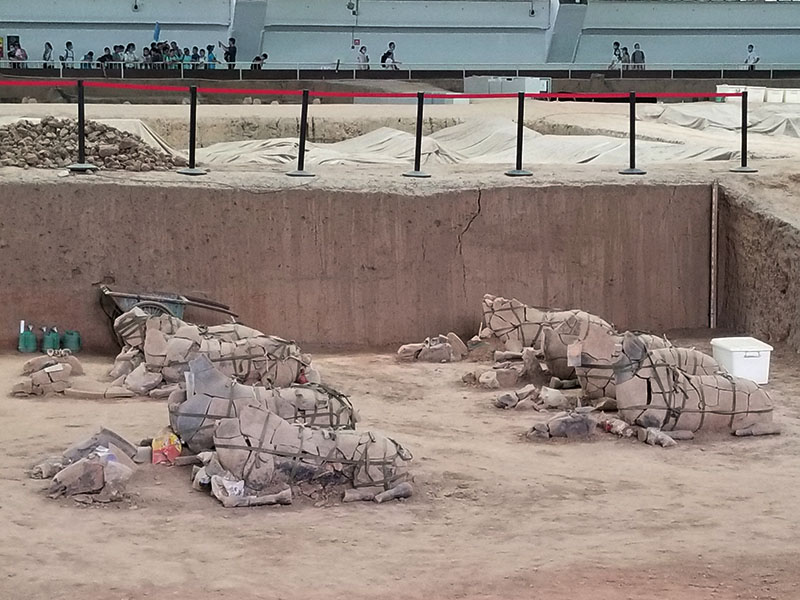 Reconstruction of a piece of terracotta artifact consumes 10 months and requires around RMB100,000. |
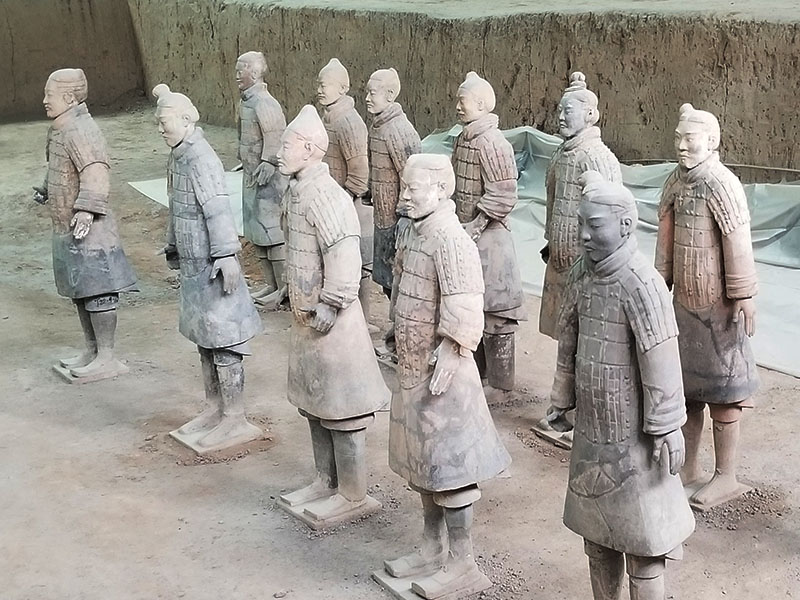 The figures vary in height (about 1.8m to 2.0m tall) according to their roles, while the tallest being the generals. |
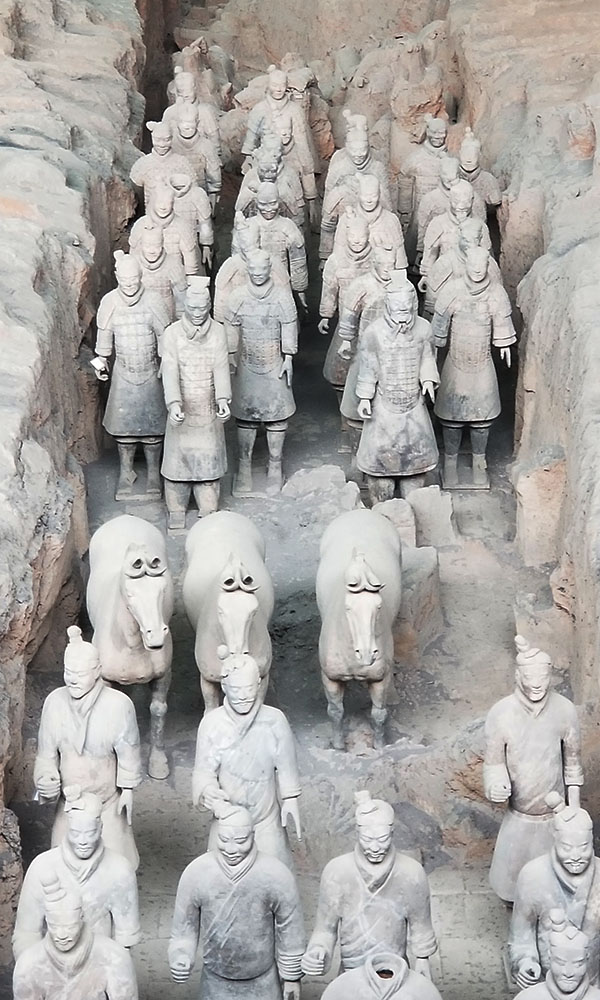 The first 3 rows of unarmored infantry illustrate crossbowmen able to launch a long-range attack. They were prisoners who could be free men after the war. |
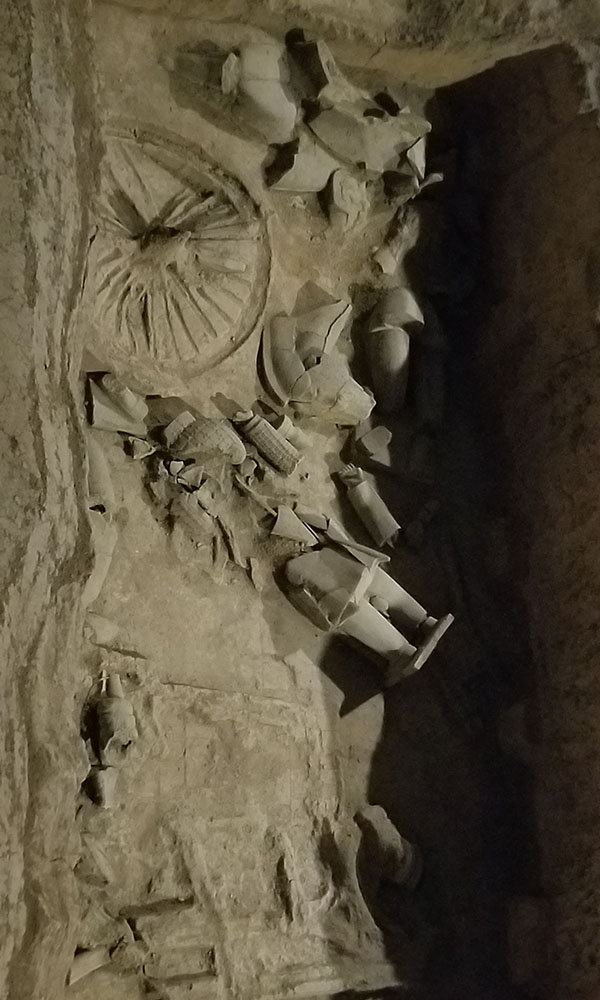 The three pits opening to public contain more than 8,000 soldiers, 130 chariots with 520 horses, and 150 cavalry horses. |
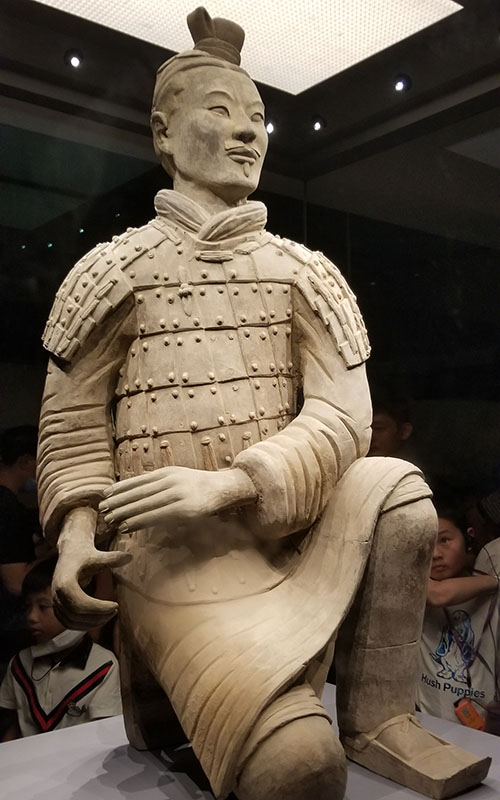 The figures generally include armored infantry, unarmored infantry, cavalrymen, helmeted drivers of chariots, spear-carrying charioteers, kneeling crossbowmen, archers, etc. |
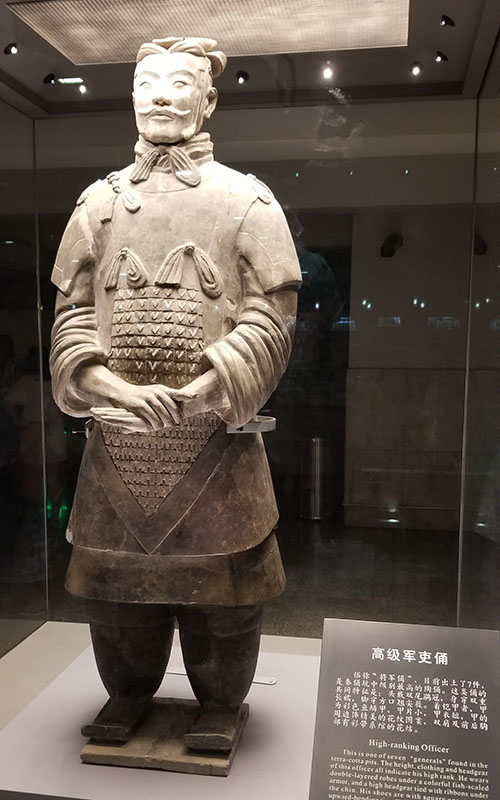 Each soldier has distinctive facial expressions. Also the hairstyles and clothing of different ranks of soldiers and military officers differ from each other. |
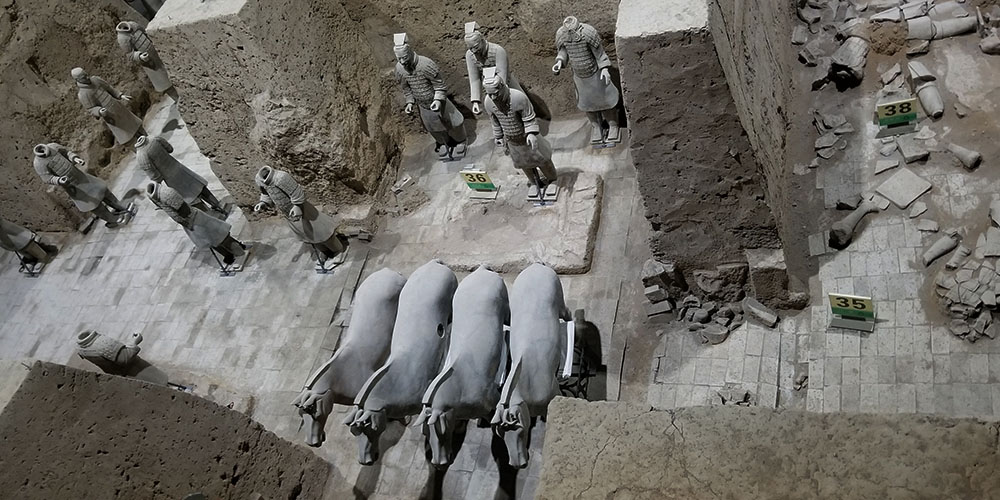 Pit 3, with an area of 520 sqm, was the headquarters of the entire Terracotta Warrior. Yet, no terracotta warrior commander-in-chief has been found as some experts believe that the Emperor Qin was the commander-in-chief himself, and in order to defend the emperor's dignity and absolute authority, his image cannot be replicated in the pit. |
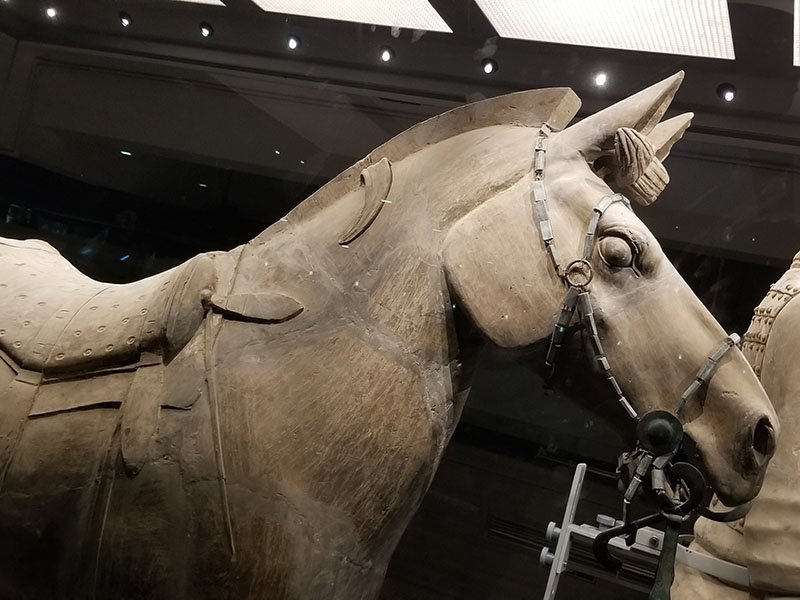 Other terracotta non-military figures were found in other pits, including officials, acrobats, strongmen, and musicians. |
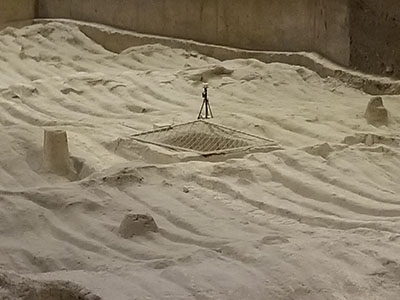 A group of farmers unearthed the first signs of the artefacts while digging a well in Shaanxi province. |
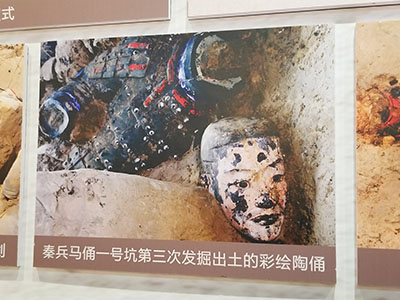 The lacquer covering the paint can curl in fifteen seconds once exposed to air and can flake off in just four minutes. Preservation of the artefacts becomes a main priority to the archaeologists. |
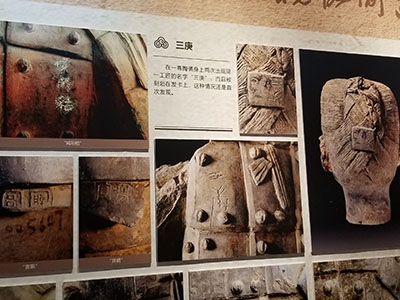 700,000 conscripted workers were involved to construct the mausoleum. Each workshop was required to inscribe its name on items produced to ensure quality control. |
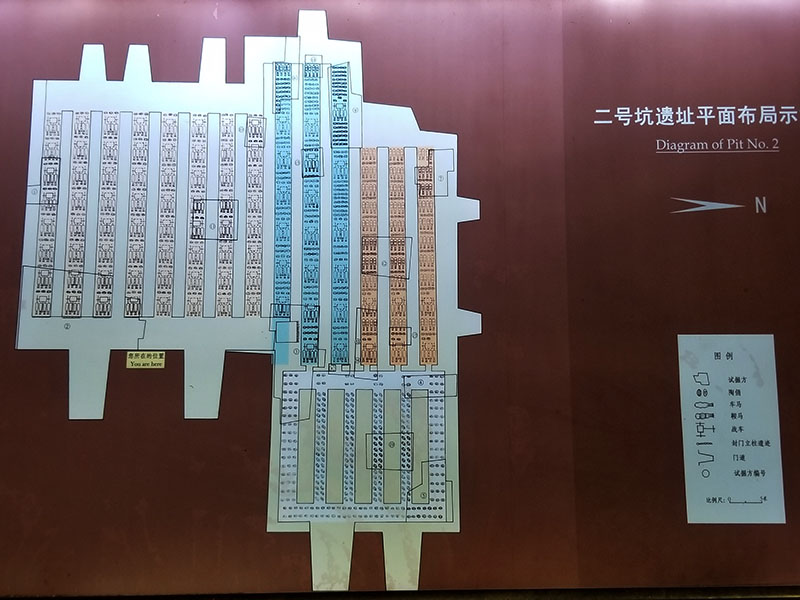 The soldiers within the pits were laid out as if to protect the tomb from the east or to conquer the east, as Emperor Qin originated from the west of China and conquered China all the way to the east. |
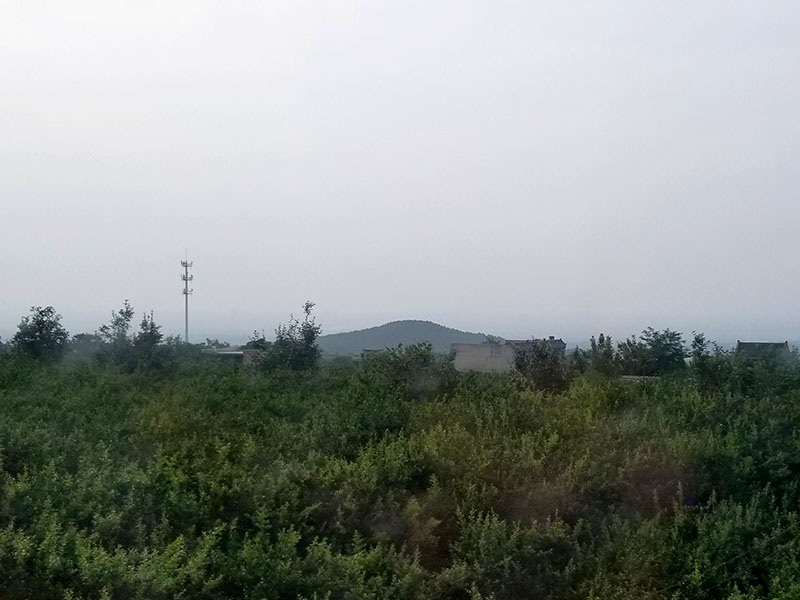 The mound where the tomb of Emperor Qin is located. 司马迁《史记》秦始皇陵穿透骊山,陵墓一直挖到地下的泉水,用铜加固基座,上面放着棺材,墓室里面放满了各种珍宝。墓室内的要道机关装着弓弩,盗墓的一靠近就会被射死。墓室里用水银模拟出江河湖海,用美人鱼的油脂做长明灯. |
|
Xi'an is more than 3,000 years old and was known as Chang'an (长安) in ancient times. For 1,000 years, the city was the capital for 13 dynasties and a total of 73 emperors ruled here. Amongst all the rulers includes the only legitimate female sovereign in the history of China, /Emperor Wu Zetian (武则天). She was the de facto ruler of the Tang dynasty, first through her husband the Emperor Gaozong and then through her sons. She subsequently became empress regnant/Emperor of the Wu Zhou dynasty of China, ruling from 690 to 705. Her extraordinary life has made into many dramas which many people nowadays know her life story. |
|
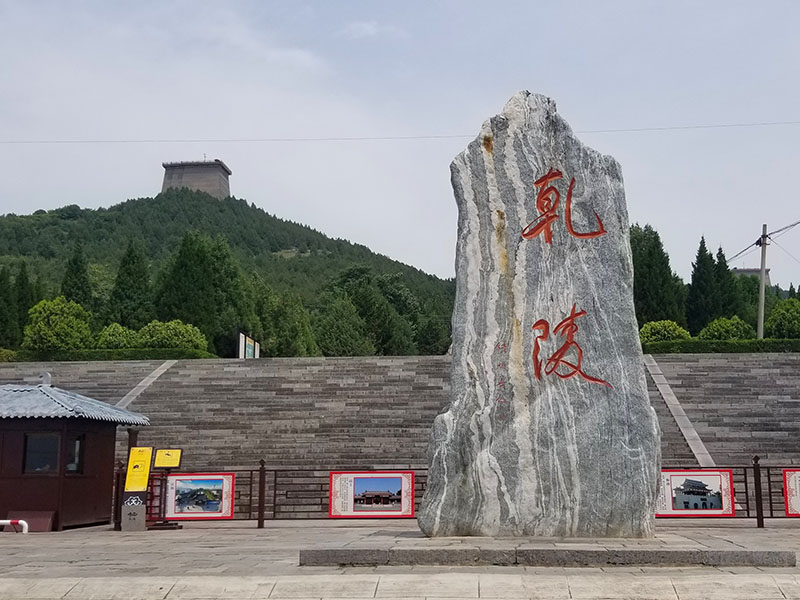 Wu was the concubine of Emperor Taizong. After his death, she married his successor—his ninth son, Emperor Gaozong, officially becoming empress consort in 655. After Gaozong's debilitating stroke in 660, Wu Zetian became administrator of the court, a position equal to the emperor's, until 705 upon her death. |
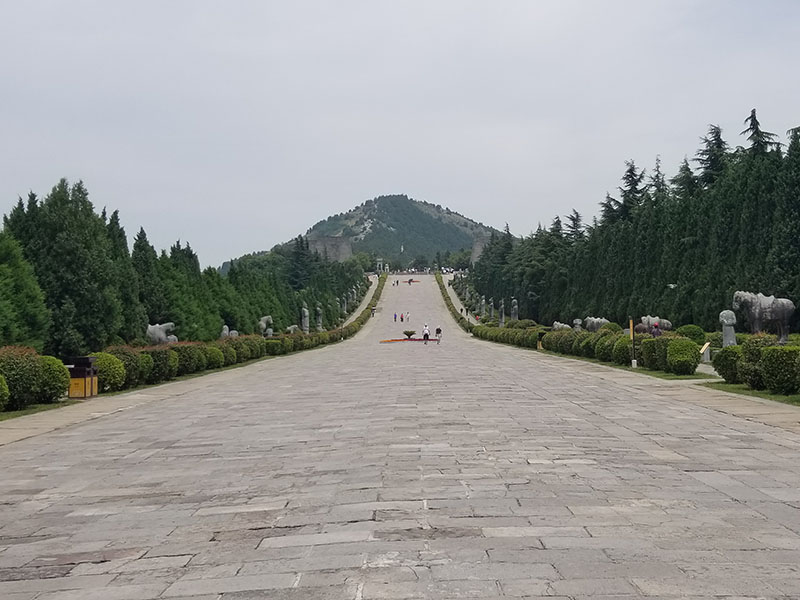 This Qian Ling Mausoleum ( 乾陵博物馆) is the only shared Emperor tomb of China for Emperor Wu Zetian, and her husband Emperor Gaozong and their family members. The tomb chambers of Emperor Gaozong and Emperor Wu are located deep within this Mount Liang. |
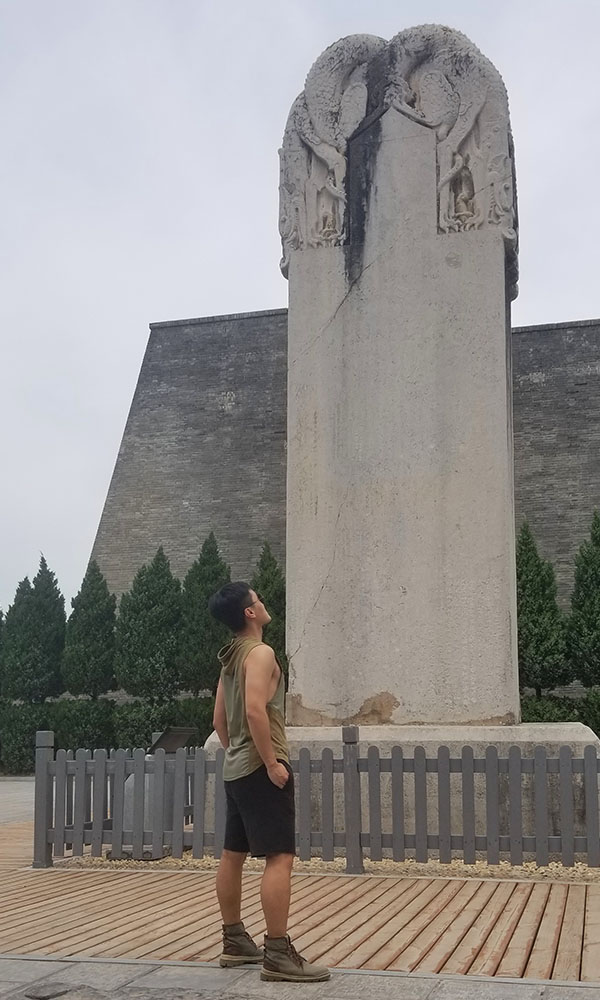 Prior to her death, Wu erected a stone monument with no inscriptions on that tablet, which is called “Wordless Stone Stele” (无字碑). There are numerous reasons to explain the empty inscription monument. Under her 40-year reign, China grew larger, corruption in the court was reduced, its culture and economy were revitalized, and it was recognized as one of the great powers of the world. Yet Wu eliminated many of her real, potential, or perceived rivals to power by means of death, demotion, and exile, including her own children. It is up to historians to interpret her achievements. |
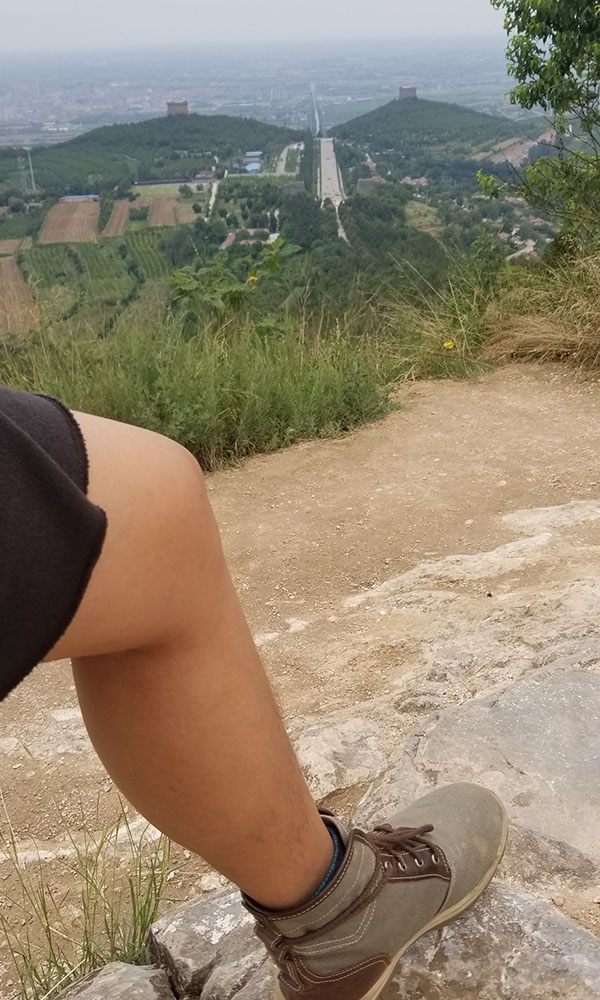 Hiked up the peak of Mount Liang. Wu was from a wealthy family, and she was encouraged by her father to read books and pursue her education. He made sure that his daughter was well-educated, a trait that was not common among women, much less encouraged by their fathers. With education comes a competent ruler. She was eventually recognized as a capable and attentive ruler even by traditional historians who despised her, and her ability at selecting capable men to serve as officials was admired throughout the rest of the Tang dynasty as well as in subsequent dynasties. |
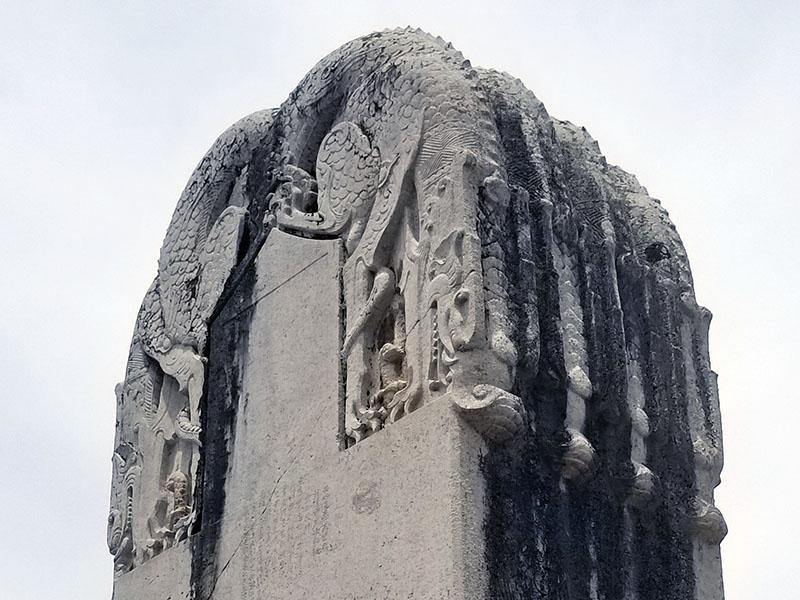 The stele features 10 dragons (9 dragons signify an Emperor and she has an extra), with 4 pairs of dragons tangled and bowing their heads, and two dragons carved on both sides raising from the bottom to the top. |
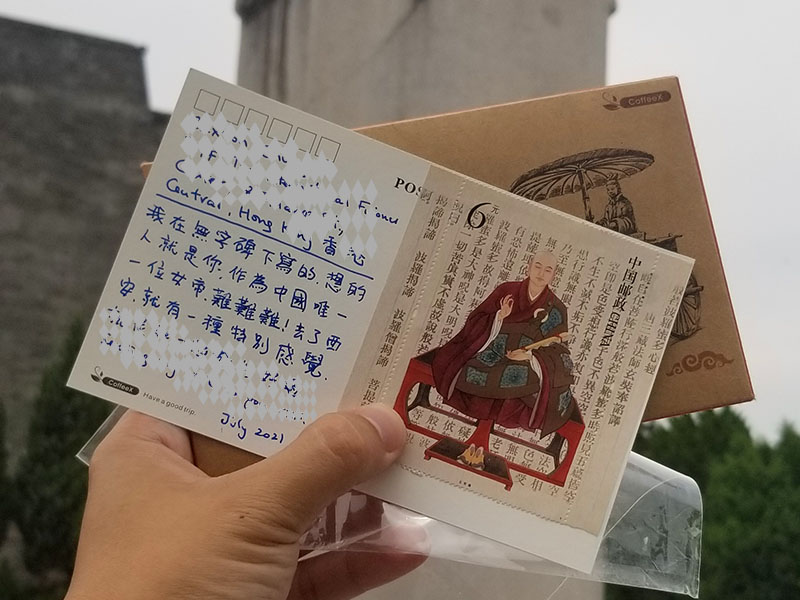 A drama about her extraordinary life was broadcasted a few years ago, and my friends dated me to visit this "Wordless Stone Stele". Yet as I am alone in in this work trip, post cards served the mean to sharing my moment to them. |
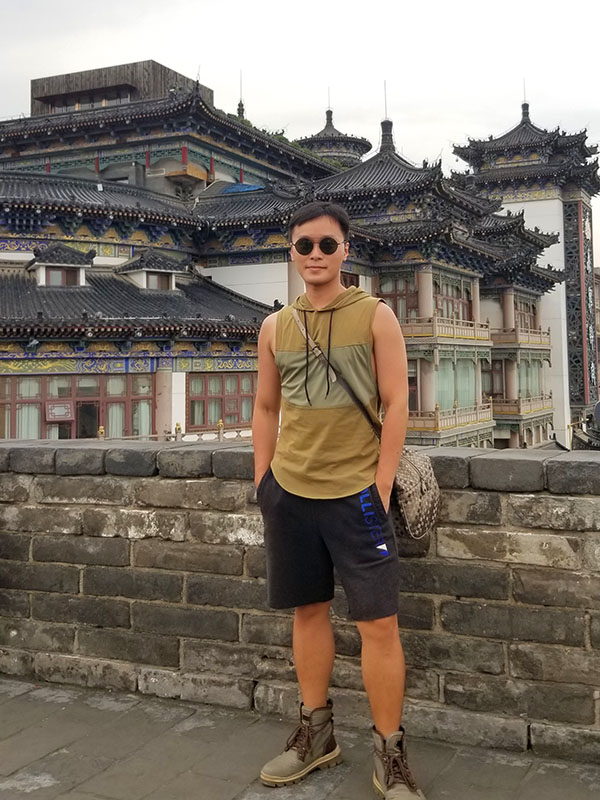 Xi'an has one of the world's best preserved city wall. The present city wall was built in the Ming dynasty (A.D.1368-A.D.1644) on the foundation of the old Chang'an Imperial city wall of Tang dynasty (A.D.618-A.D.907). |
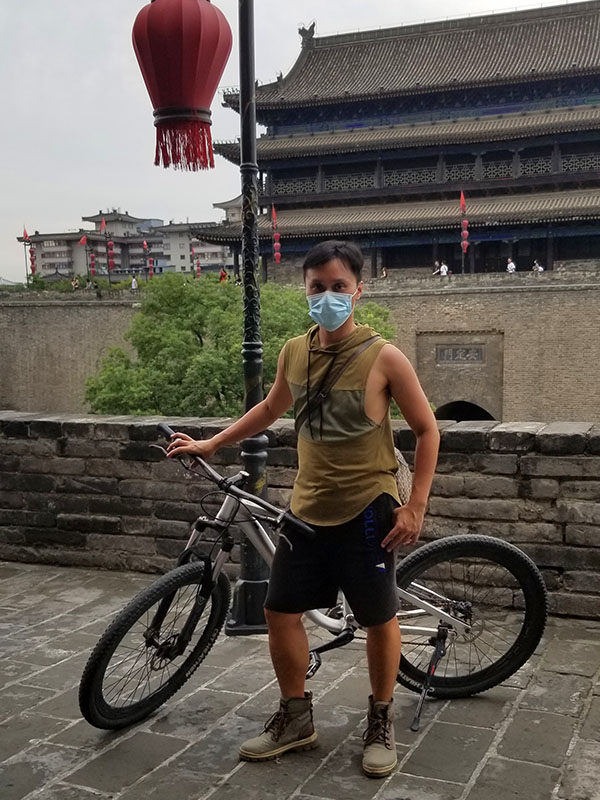 As the world's largest city wall, the Xi'an city wall is 12m high, 18m wide is its base and 15m wide on the top. Biking the 13.7km journey took me almost 3 hours from 5:30pm to 8:00pm which I could enjoy both the morning and night view of the city. |
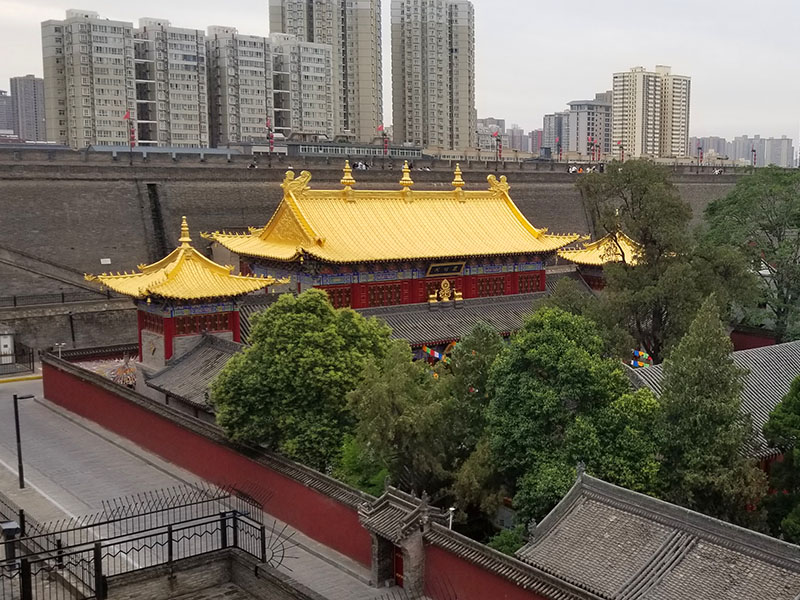 Locals often refer location in Xi'an with "Within city walls" and "Outside city walls". Structures within the city wall tend to be lower raise and retain more histories. |
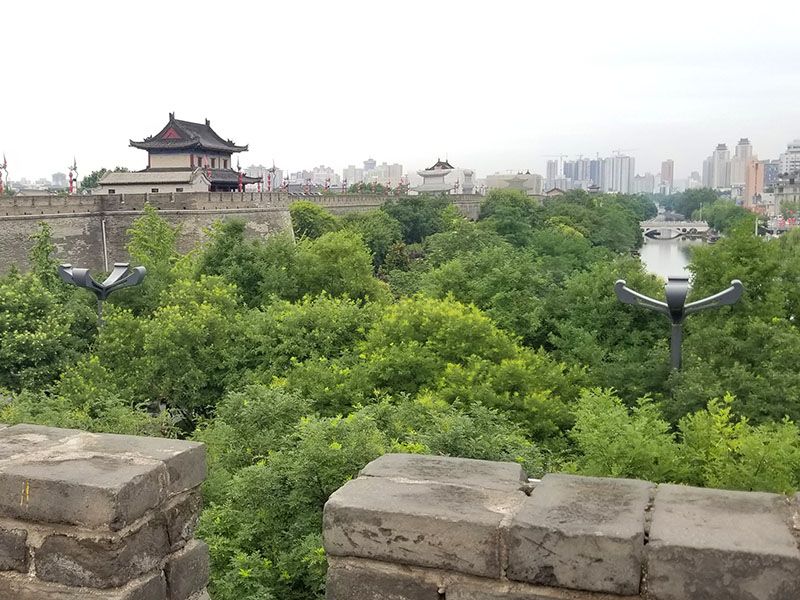 The green landscape and moat around the wall make strolling along the wall more scenic. There are also 18 city gates encircling the rectangle city center of Xi'an. Each one has its own history. |
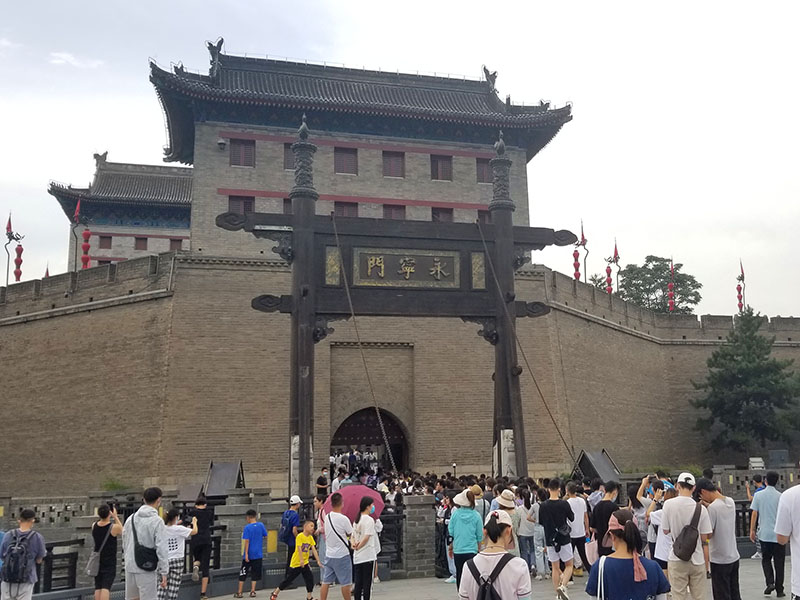 The wall includes four gates with names meaning Eternal Joy (长乐门) in the east, Eternal Peace (永宁门) in the south, Safe and Stability (安定门) in the west, and Safe Afar (安远门) in the north. This South Gate is the most beautifully decorated one. |
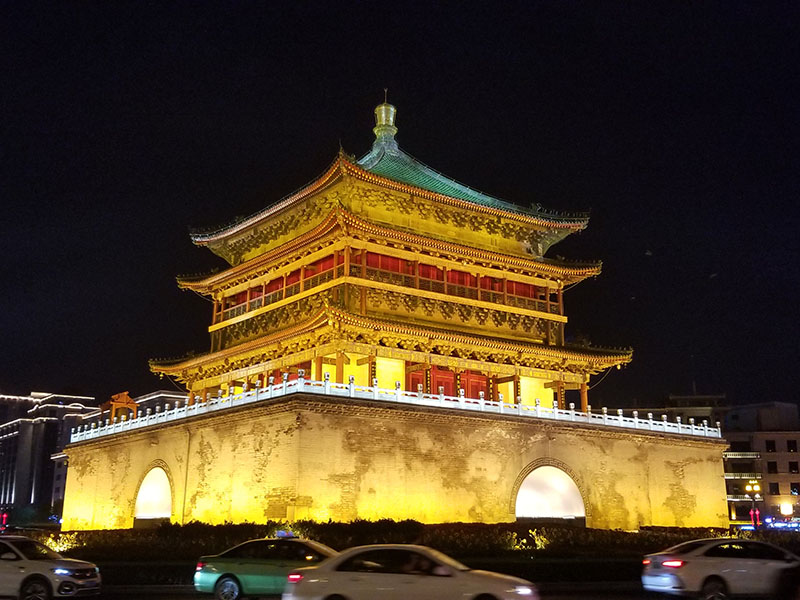 Right at the walled Xi'an city center is the Bell Tower (钟楼) which intersect East Road, West Road, South Road and North Road. It is the largest and most preserved one amongst the many bell towers left over from ancient China. |
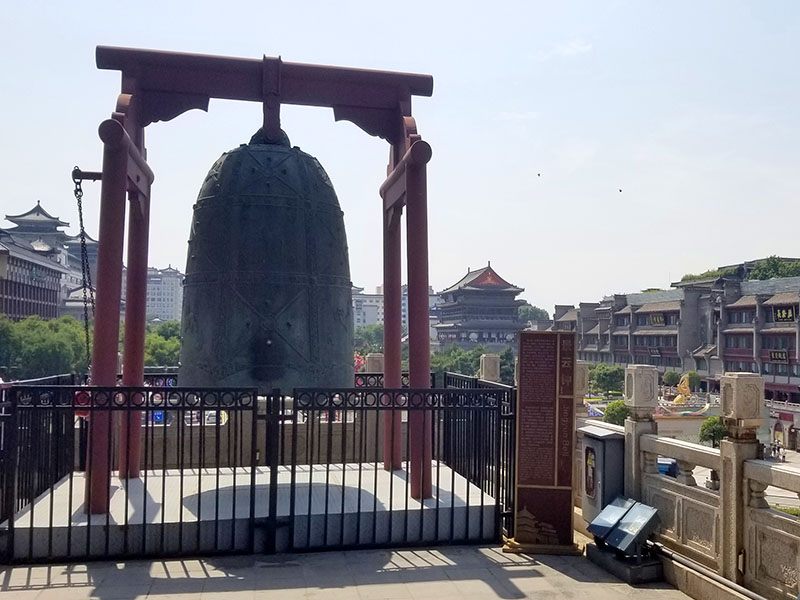 The Bell Tower and Drum Tower were built in 1380s Ming dynasty and mainly served for time reporting and publishing news in ancient times. Currently the Drum Tower locates about 200m west of the Bell Tower. |
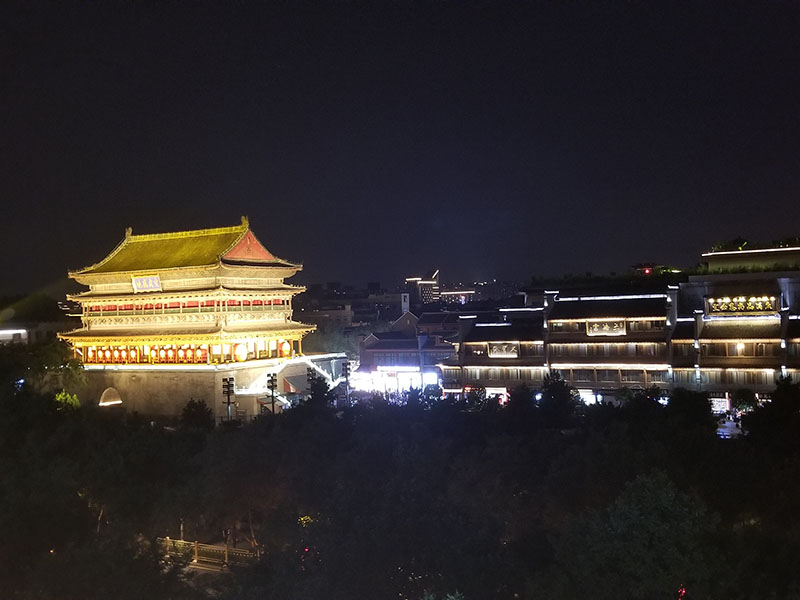 My hotel room view of the Drum Tower (鼓楼). In contrast to the Bell Tower, where the bell was stricken at dawn, drum was beat at sunset to indicate the end of the day. |
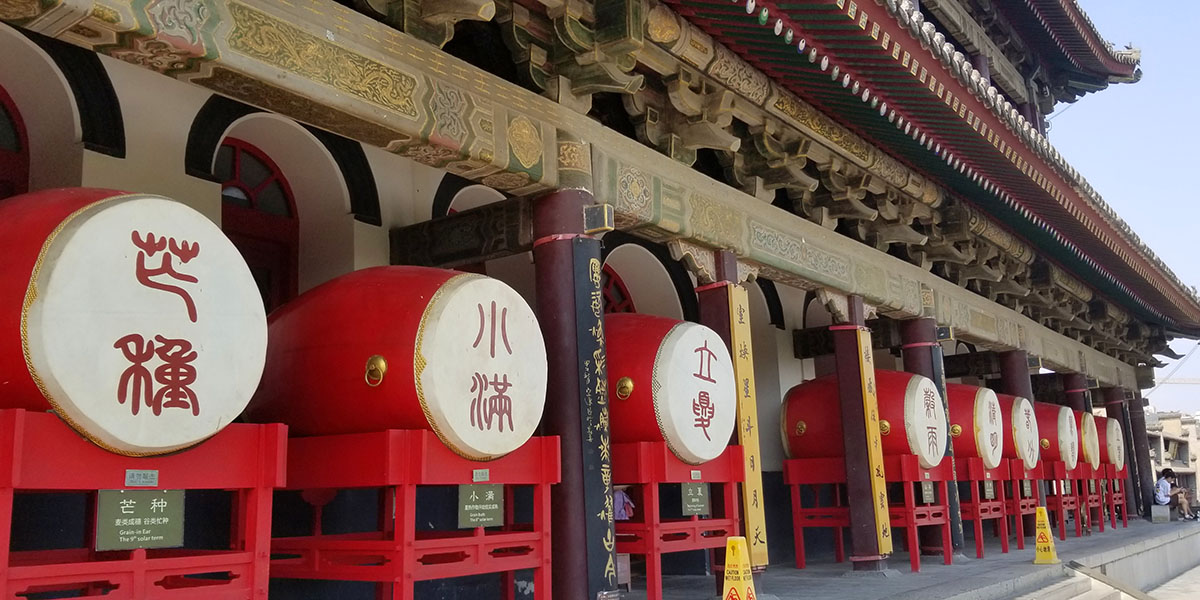 The Drum Tower stations 24 large drums. Each was decorated with intrinsic and beautiful Chinese writing denoting the 24 seasonal changes in a year. I was born on the date of Mangzhong (芒种). |
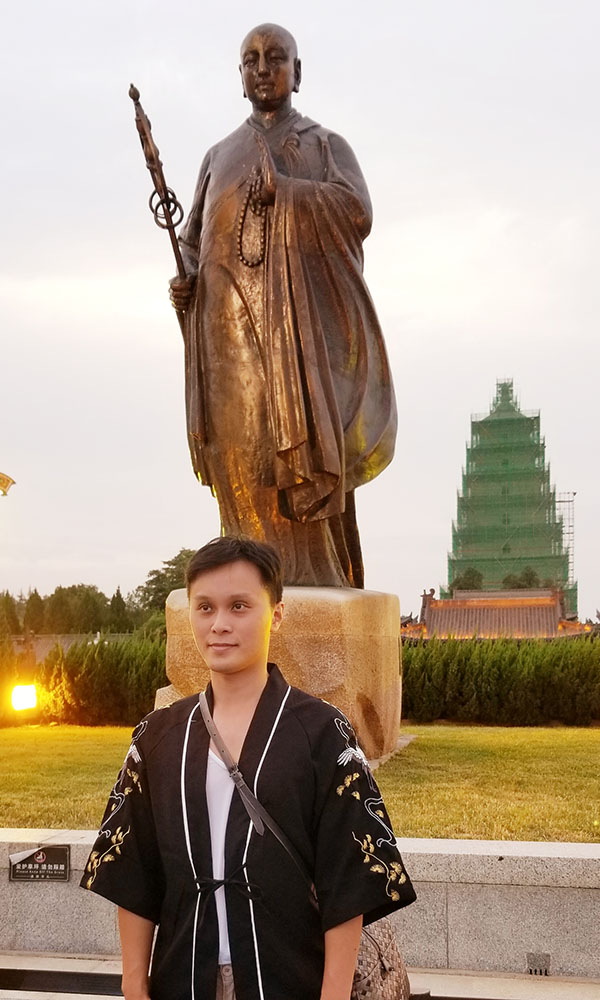 Xuanzang (玄奘 or 唐三藏) in front of the Big Wild Goose Pagoda (大雁塔). He was born in Henan province in 602 and became famous for his 17 years overland journey to India, which is recorded in detail in the Great Tang Records on the Western Regions (大唐西域记). His journey inspired the famous Chinese novel of Journey to the West (西游记). Not until I visited Xi'an and learned his journey I thought he was a fictional character. |
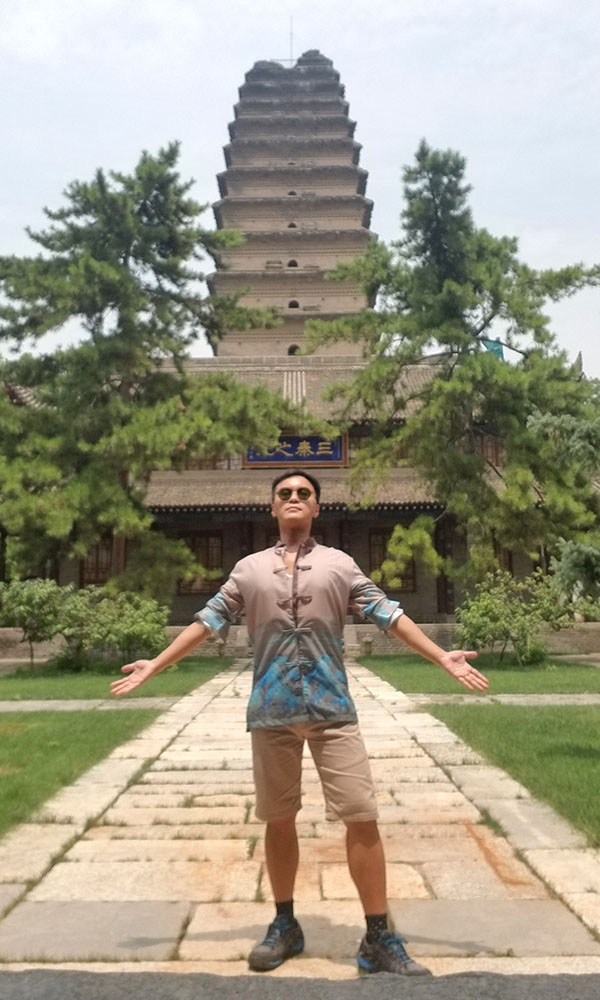 Small Wild Goose Pagoda (小雁塔) along with the Big Wild Goose Pagoda are the signature structures of Xi'an. After returning from India, Xuanzang retired to a monastery at Big Wild Goose Pagoda and devoted his remaining life to translating Buddhist texts until 664. He also translated the famous Heart Sutra (心经). The pagodas hold the sacred sutras and figurines of Buddha Xuanzang and fellow pilgrims brought back from India while the temples were the main centres for translating Buddhist texts. |
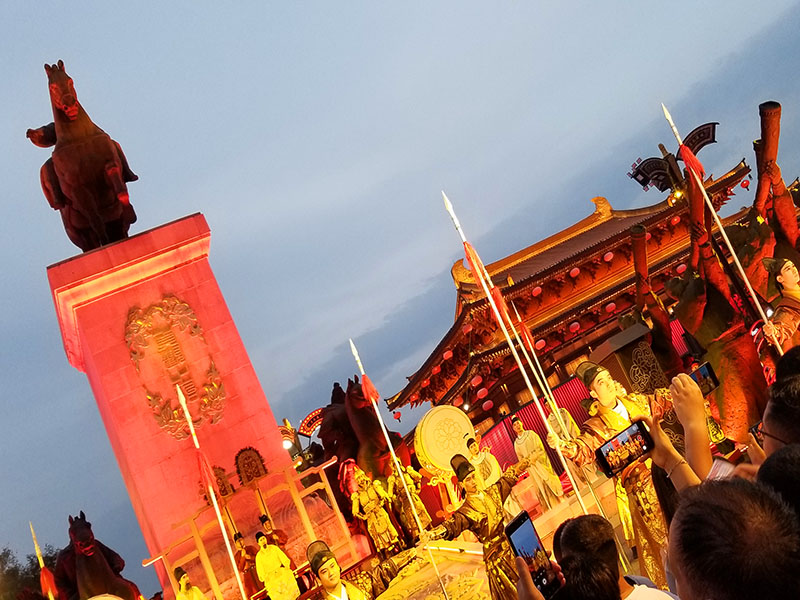 In 2018, the area surrounding the Big Wild Goose Pagoda has been developed into a large-scale cultural tourism project of Grand Tang Dynasty Ever-bright City (大唐不夜城). |
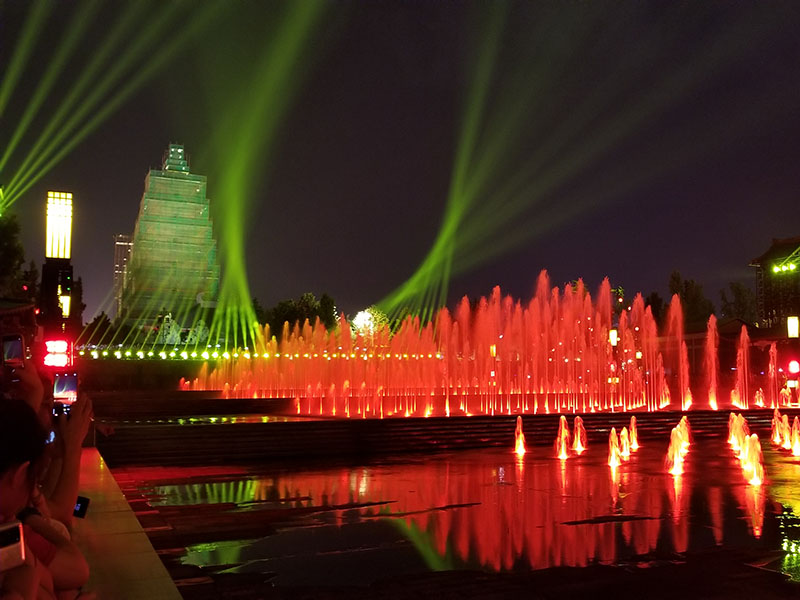 The area comprises the largest musical fountain in Asia, shopping malls, museums, arts centres and cultural performances to recreate the lively and bustling scene of the prosperous Tang Dynasty. |
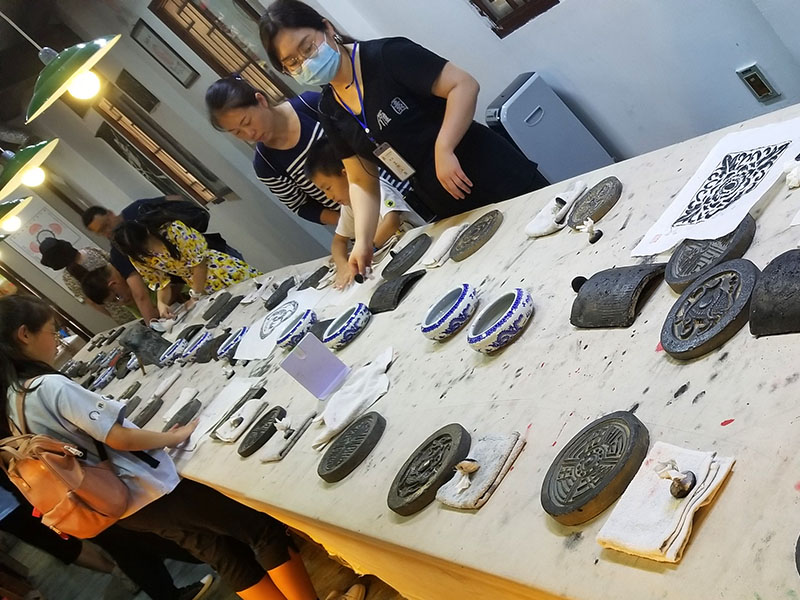 Beside the Small Wild Goose Pagoda comprises workshops for intangible cultural heritage, including rock rubbing prints (石拓印) and shadow puppet (皮影戏). It's an amazing experience to participate in culture activities which enable me to feel the rich history of this ancient city of Xi'an. |
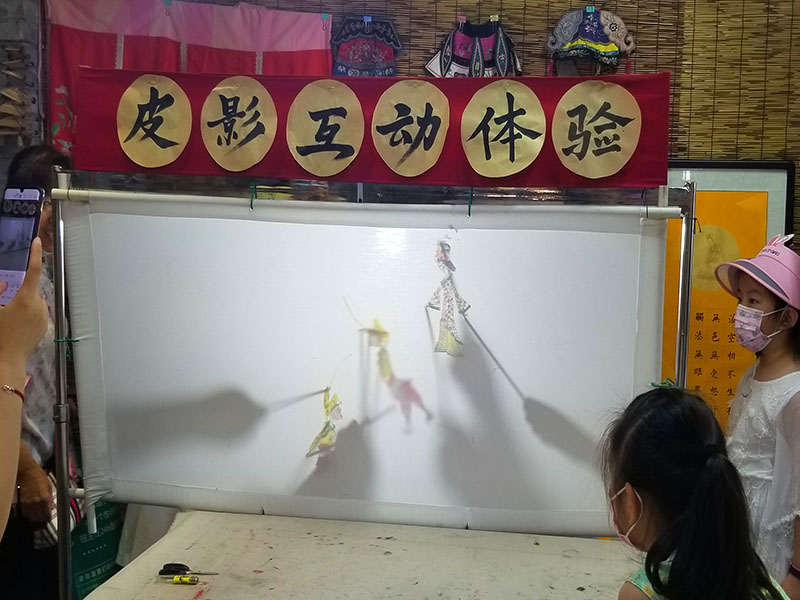 Shadow puppet theatre likely originated in Central Asia-China or in India in 1000 BC which is an ancient form of storytelling entertainment like modern cinema. The shadow puppets were made from buffalo skin which is sturdy and semi-transparent so the colored figures can be transluced to the screen. |
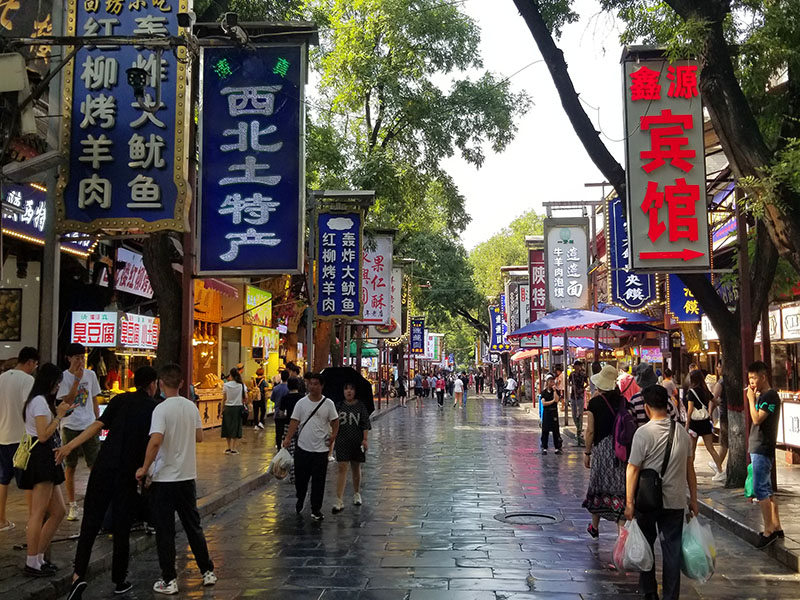 Huimin Street (回民街) is a Muslim community in the city. The street is famous as a "snack street" because delicious local Xi'an delicacies, Muslim specialty food, and typical Shaanxi snacks can be found here. |
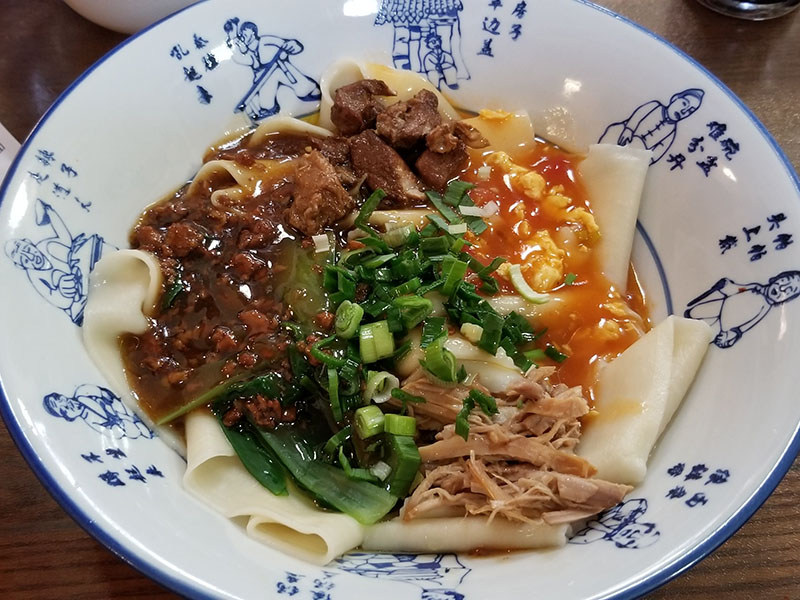 Biang Biang Mian is a local specialty noodle dish that is unique and tasty. The wide noodles are spiced, have a broth, and include toppings such as eggs, tomatoes, beef, etc. |
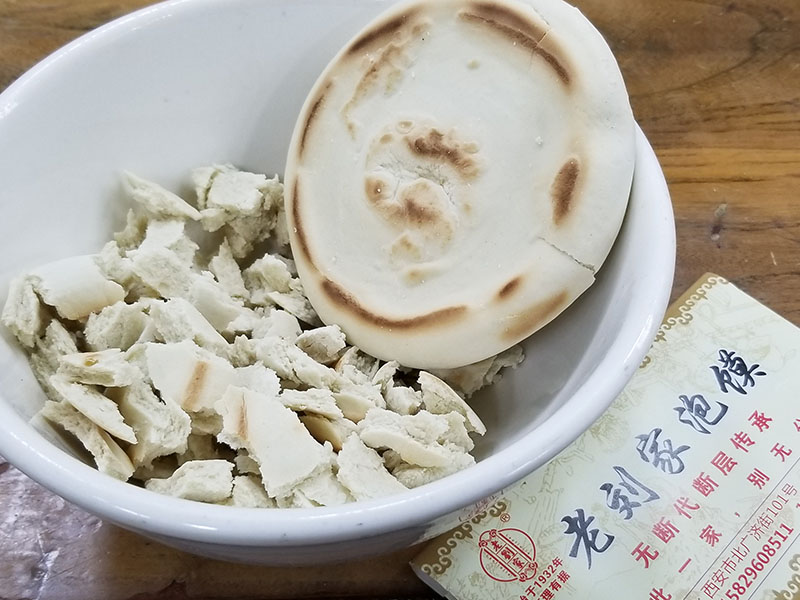 Mutton with Shred Bread (羊肉泡馍) is one of the signature dishes of the area. It consists of a piece of thick, dry and chewy bread and a kettle of mutton soup. |
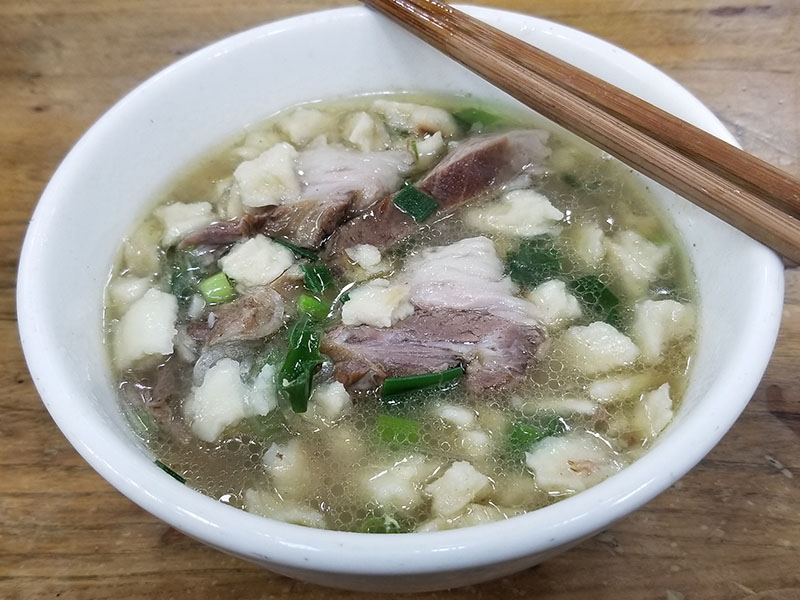 Diners need to shred the bread and put the shreds in a bowl. Soup is then poured over the shreds along with meat and vermicelli. The trick for a delicious dish is to shred the bread as small as possible. |
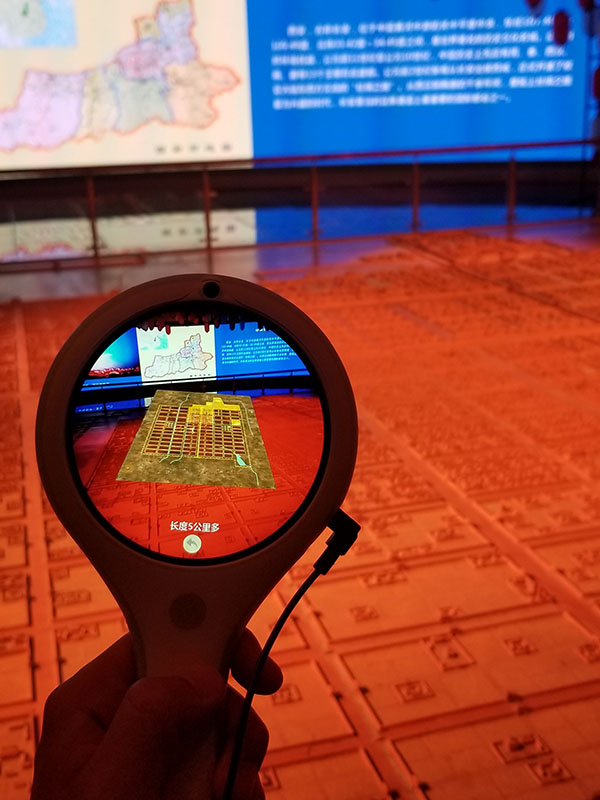 The ancient walled city of Xi'an. A major everyday Chinese word "thing" was derived from the layout of Xi'an. “买东西” 中的 “东西” 始于唐代长安城两大市集 “东市” 和 “西市”。 |
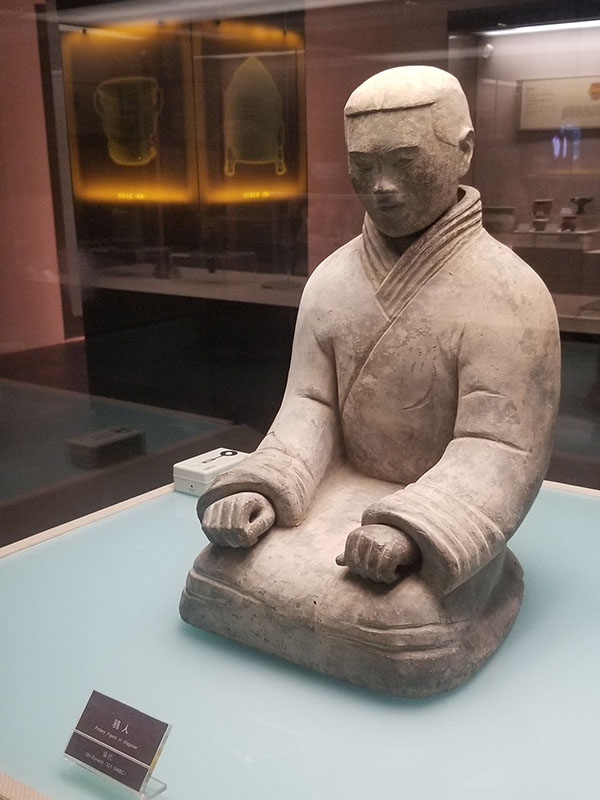 Exploring the Xi'an Museum (while Shaangxi Province Museum was full). The pottery dated back to the Qin Dynasty (220 BC) showing the standard sitting posture of the era. |
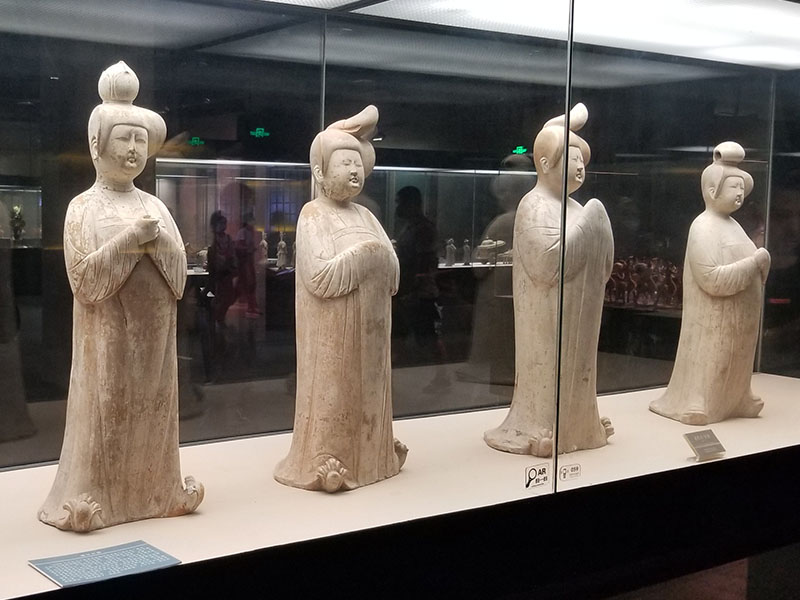 These potteries showing the standard of female beauty back in the Tang Dynasty (618AD - 907AD) prefers more round and curvy. |
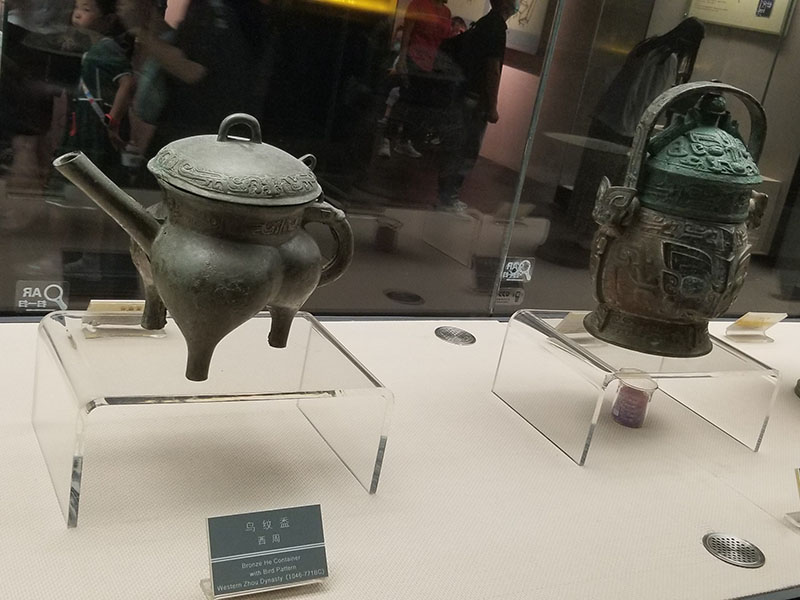 Bronze containers with bird pattern dated back to West Zhou Dynasty of 1046BC - 771BC. Back in those days, only nobles can use bronze-ware. |
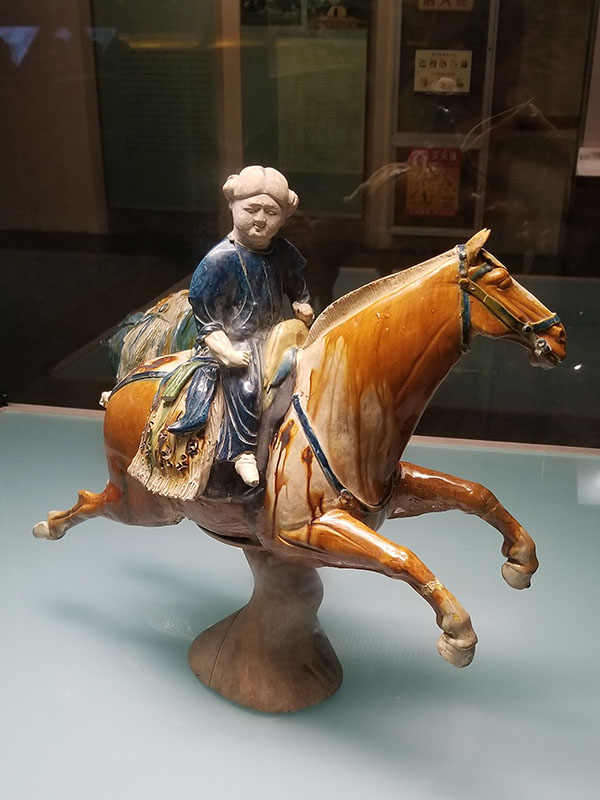 This pottery is one of the important artefacts of the museum as the three colors used and flying horse making process were unique and advance back in the Tang Dynasty. |
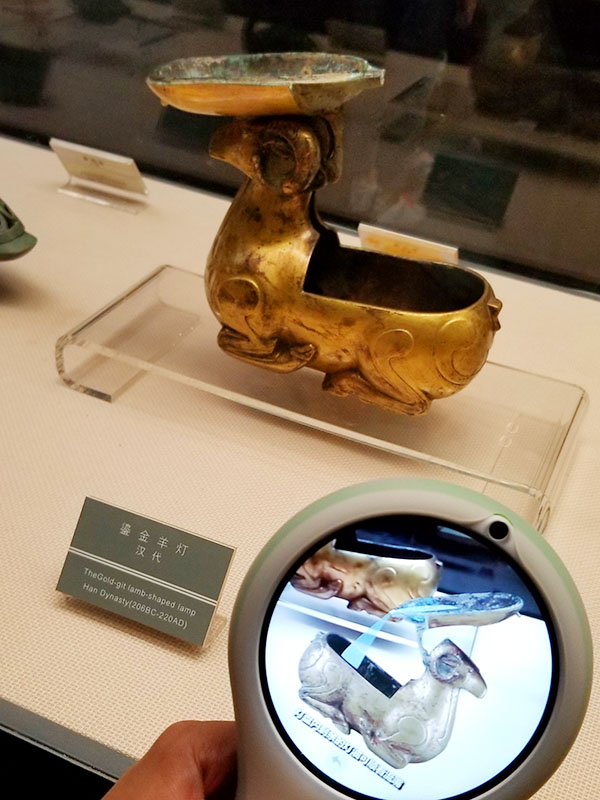 This golden lamb-shaped oil lamp was from Han Dynasty (220BC - 200AD). The VR portable guide can show us how the oil can be recycled and poured back to the base. |
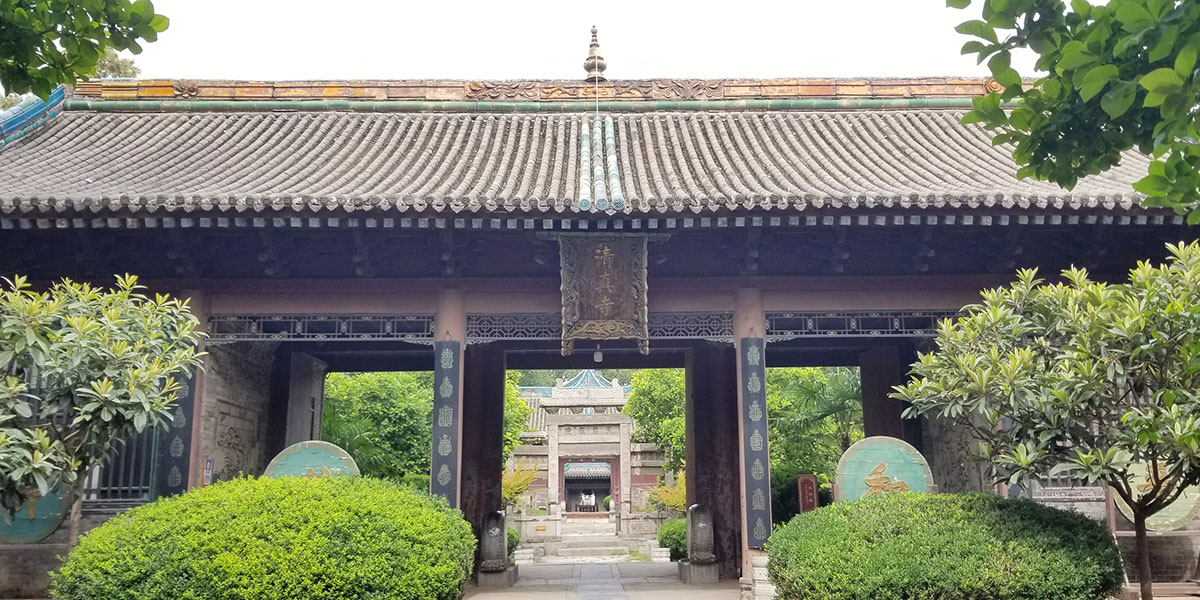 Grand Mosque (大清真寺) is famous as it is the very first mosque ever built in China. It was first built in 742AD with a perfect mixture of Islamic and Chinese architecture styles near the Muslim Street district. As Xi'an was the beginning/end of the ancient silk road and so was a centre of foreign religion influence. |
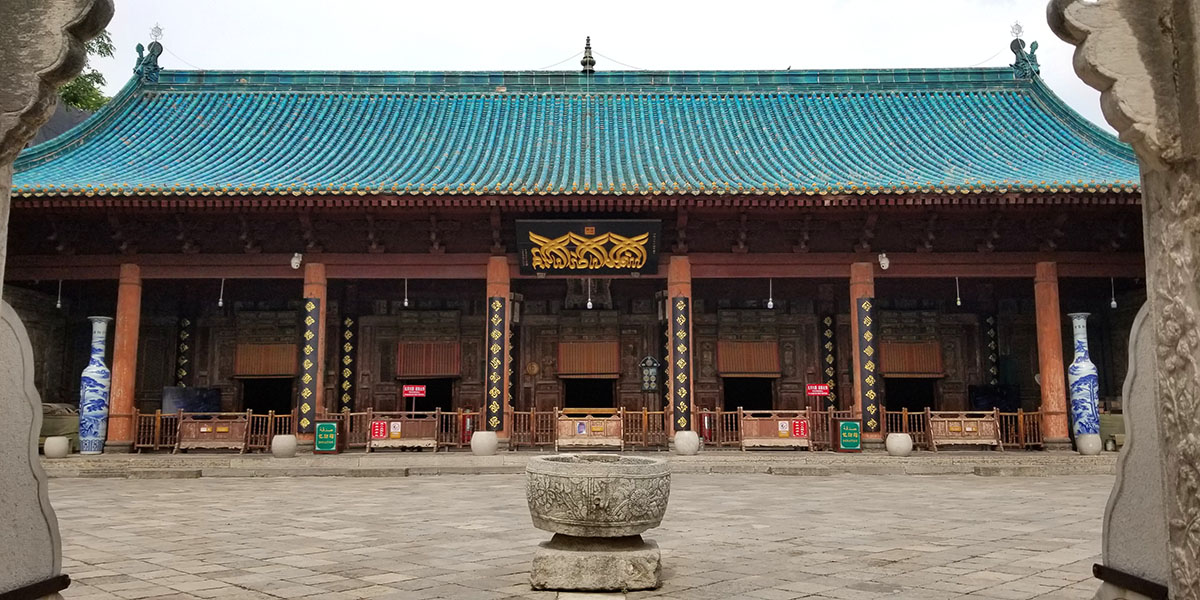 After walking westward through several monumental gates, pavilions and four courtyards, I arrived the prayer hall of the Grand Mosque, which of course has its praying wall on the west so worshipers pray toward Mecca. |
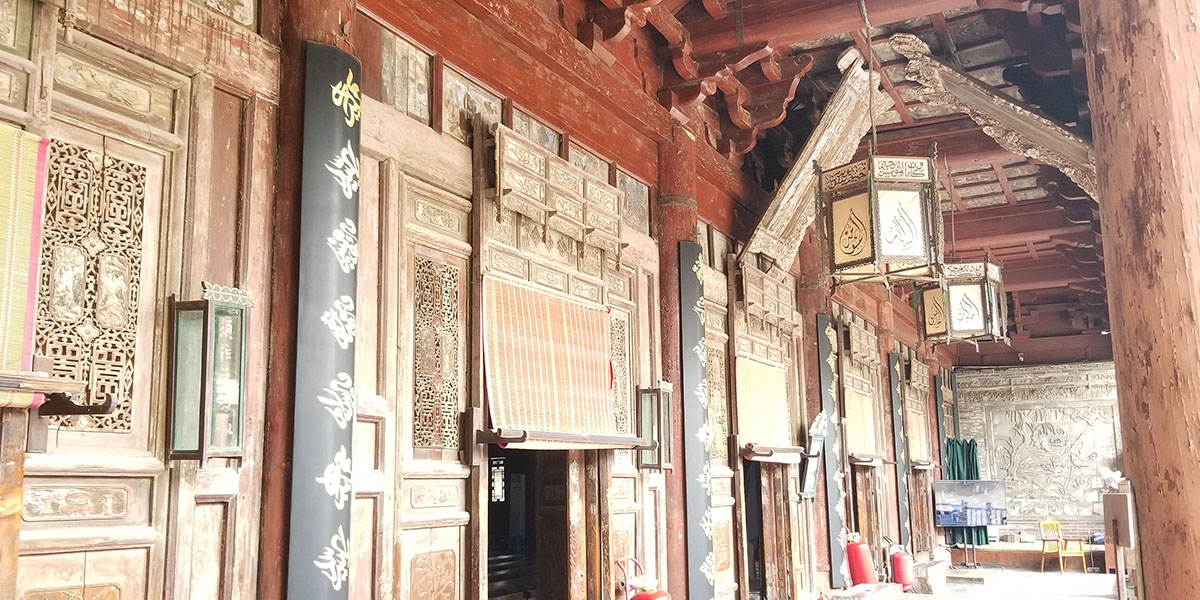 The prayer hall has seating for 1,000 worshipers and only Muslim can enter. |
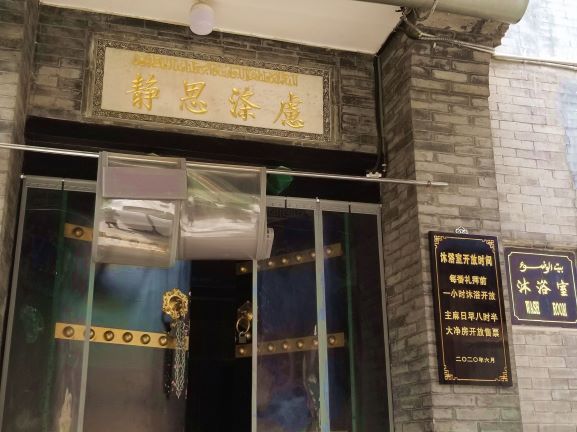 The mosque is still active for worship, with bathing hall and kitchen, which adds authenticity to the heritage site. |
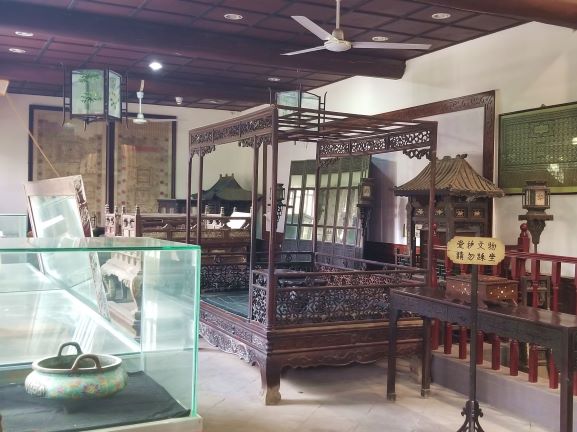 Many delicate antiques are stored in spare halls. Fortunately the climate of Xi'an tends to be dry. |
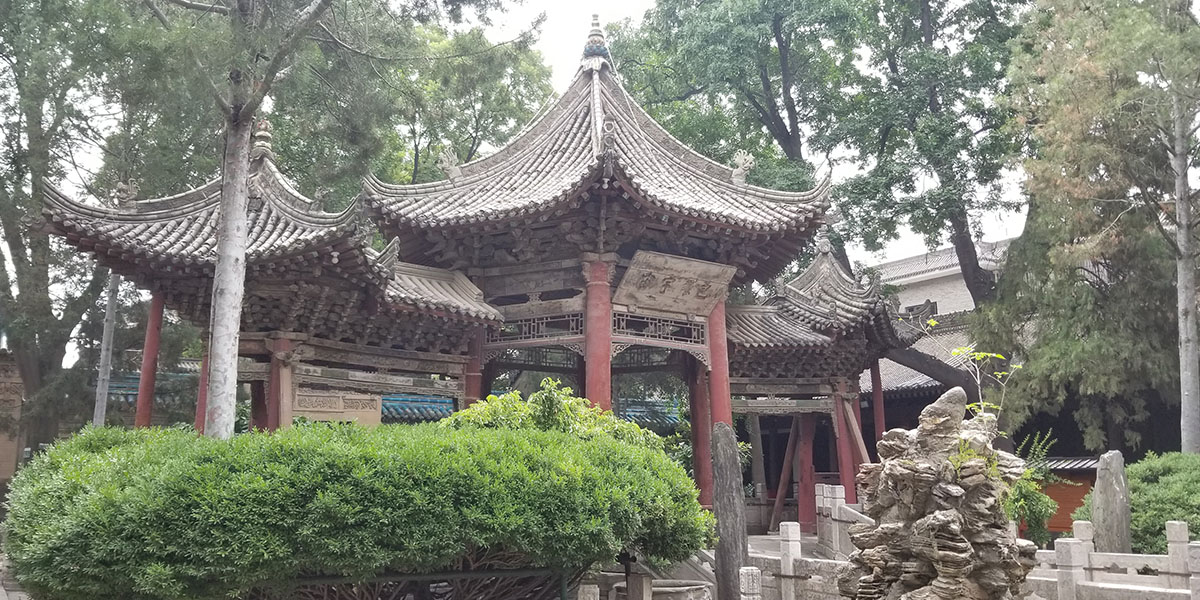 As most of the heritage sites in Xi'an have been refurbished, this Grand Mosque has retained the dated look that I appreciate. I was grateful for this less crowd authentic visit. |
|
Luoyang, Henan Province (河南省洛阳市) - Longmen Grottoes (龙门石窟) The grottoes are some of the finest examples of Chinese Buddhist art. Housing tens of thousands of statues of Shakyamuni Buddha and his disciples.
|
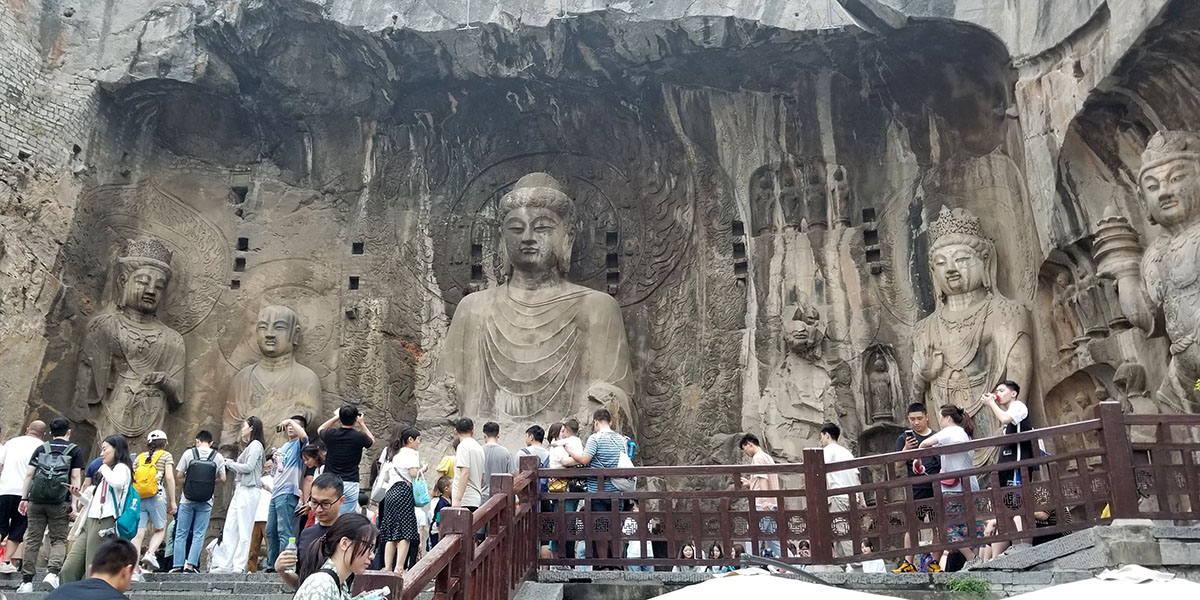 Fengxian Temple (奉先寺) is the largest of all caves carved on the west hill built between 672 and 676 for Empress Wu Zetian, which she was modelled as the Buddha. The carvings are claimed to be the ultimate in architectural perfection of the Tang dynasty. The shrine inside the cave measures 39m x35m. It has the largest Buddha statue at the Longmen Grottoes. |
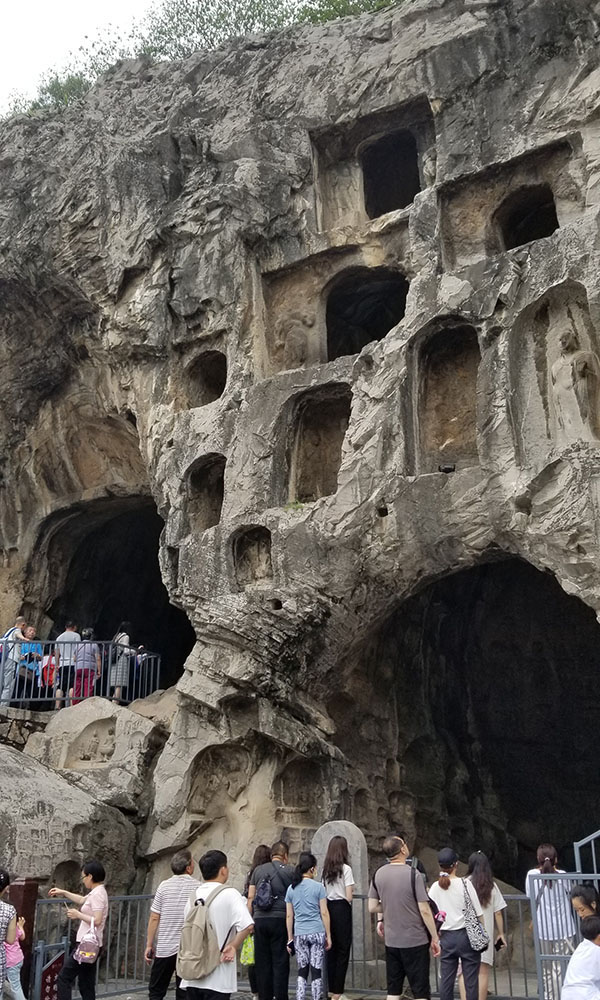 The earliest history of the creation of Longmen Grottoes is traced to the reign of Emperor Xiaowen of Northern Wei dynasty when he shifted his capital to Luoyang. |
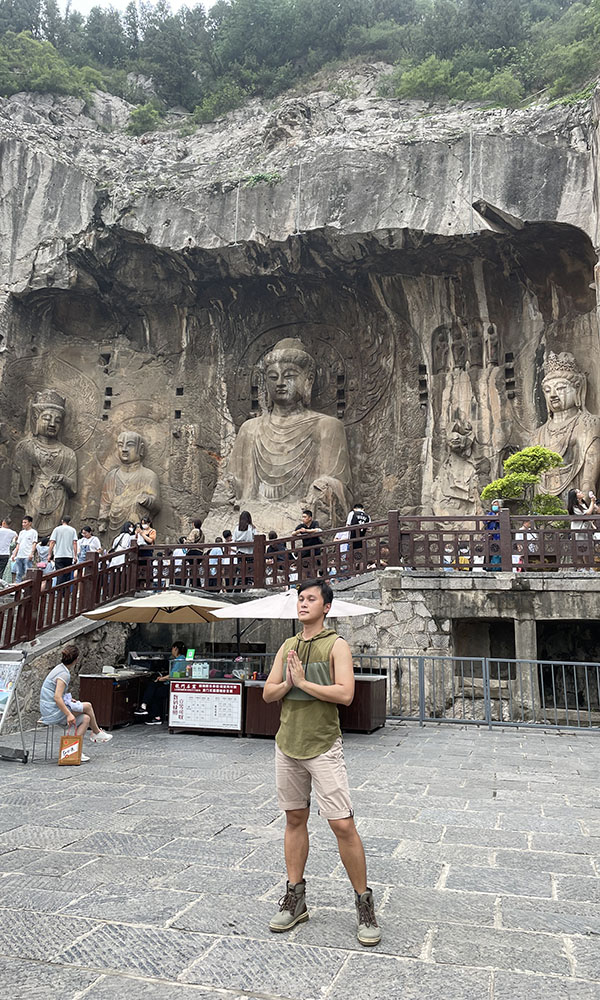 Then Luoyang served as the historic capital of China for 13 dynasties. The grottoes were excavated and carved over the period from 493 to 1127. |
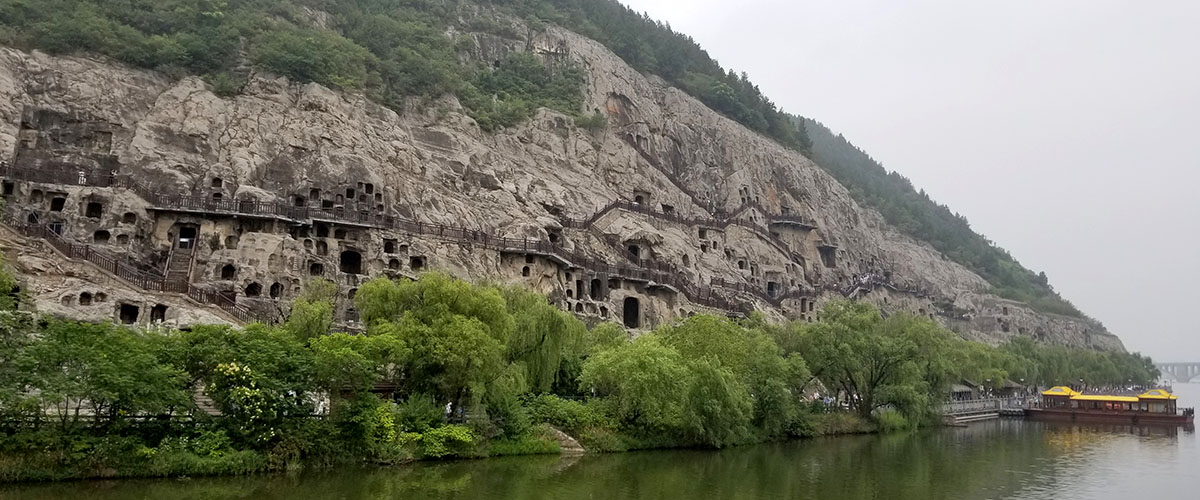 The Buddha figures, many were once painted, were carved from the limestone cliffs of the Xiangshan (香山) and Longmenshan (龙门山) along the River Yi (伊河). |
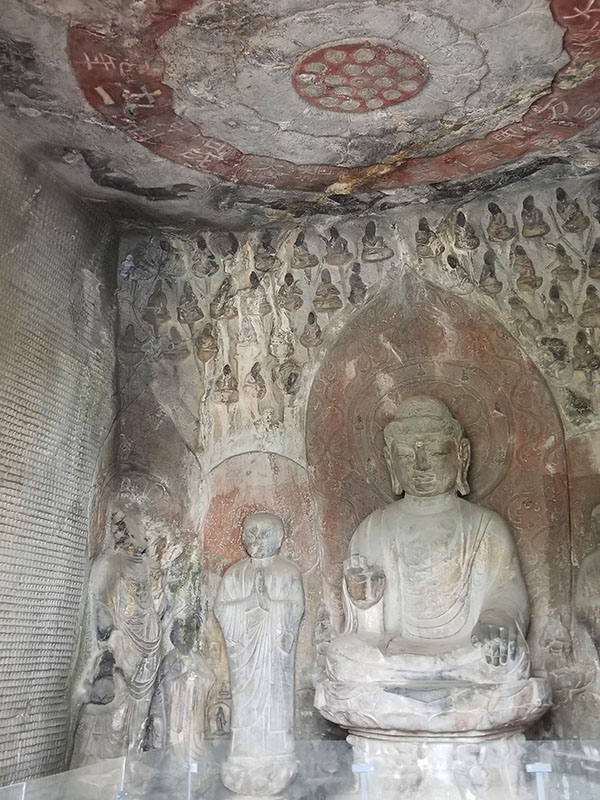 Walking along the grottos, history is displaying itself in front of our eyes. Major artefacts were removed by Western collectors and souvenir hunters during the early 20th century, while China was in decline. |
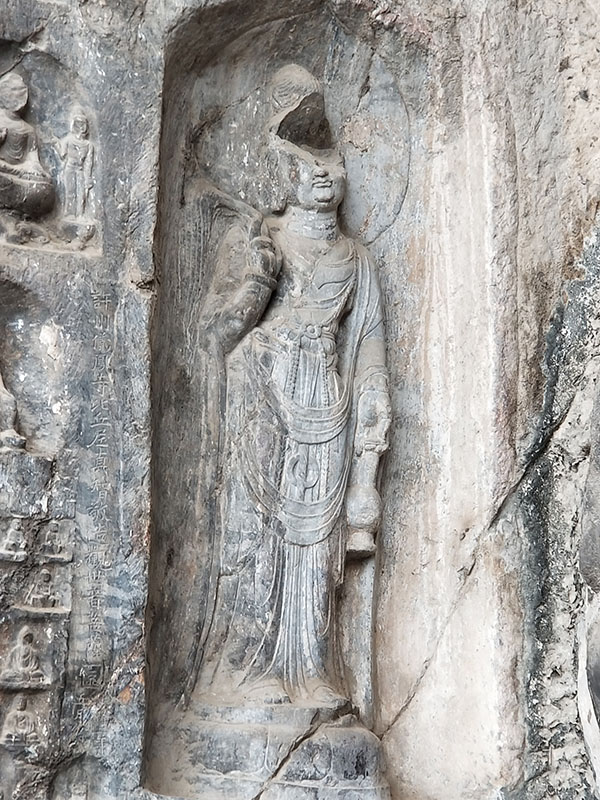 On the other hand, the heads of many statues were also destroyed during the Cultural Revolution during the mid 20th century by the Chinese citizens themselves. This Buddha figures were believed to model Empress Wu. |
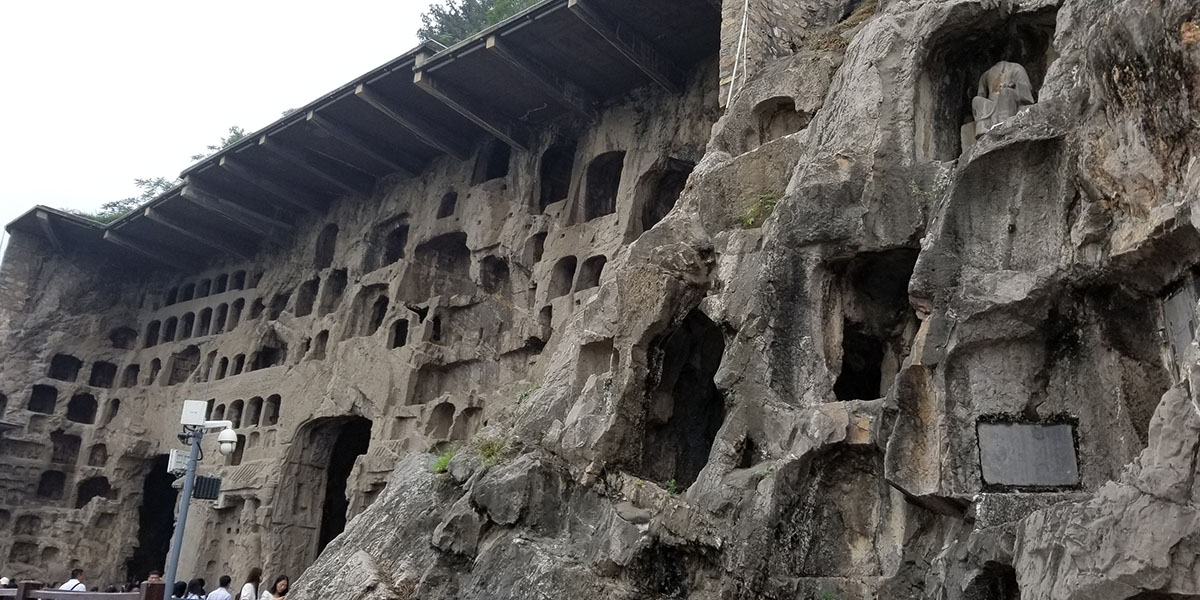 Two murals taken from the grottoes are reported to be displayed in the Metropolitan Museum of Art in New York and the Nelson-Atkins Museum of Art in Kansas City. Yet, they are well preserved while most of the grottos at Longmen have the Buddha statues removed. |
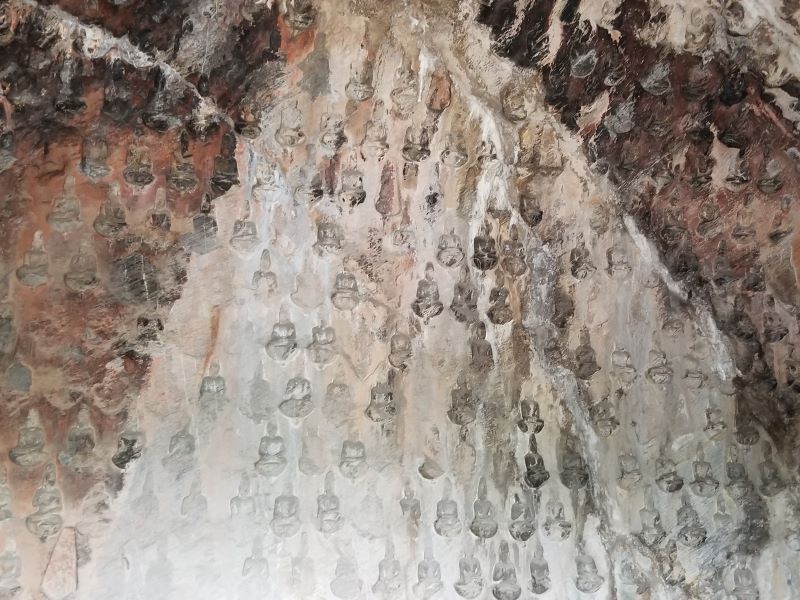 Thousand Buddhas Cave, dated to 680. |
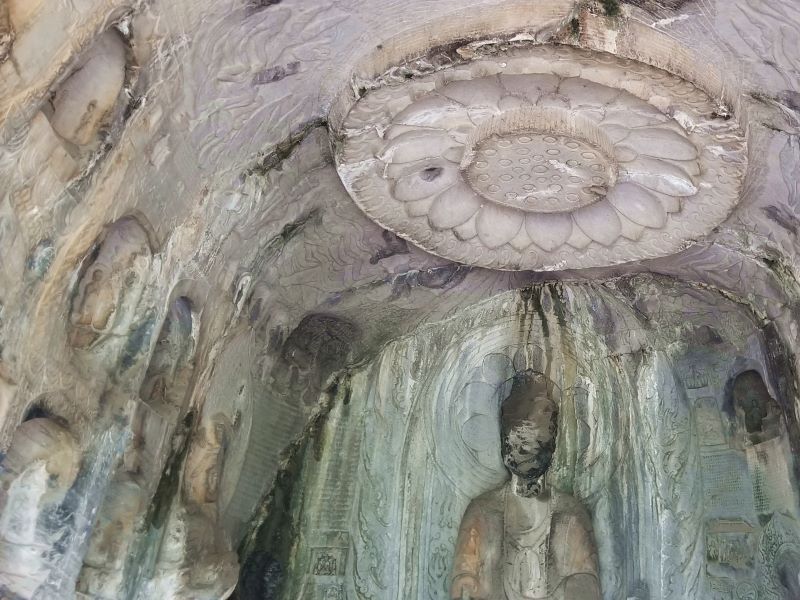 The Lotus Flower Cave (莲花洞), dated to 527. |
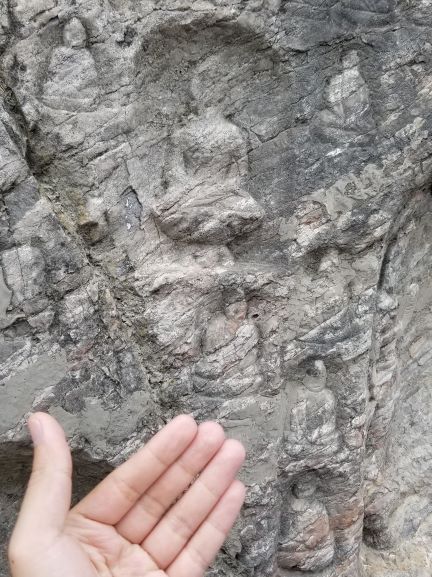 We arrived the Grottos at 10am with the thrill of witnessing history and I left in the evening with a mixed feeling of sad and sorrow as I understood the history. |
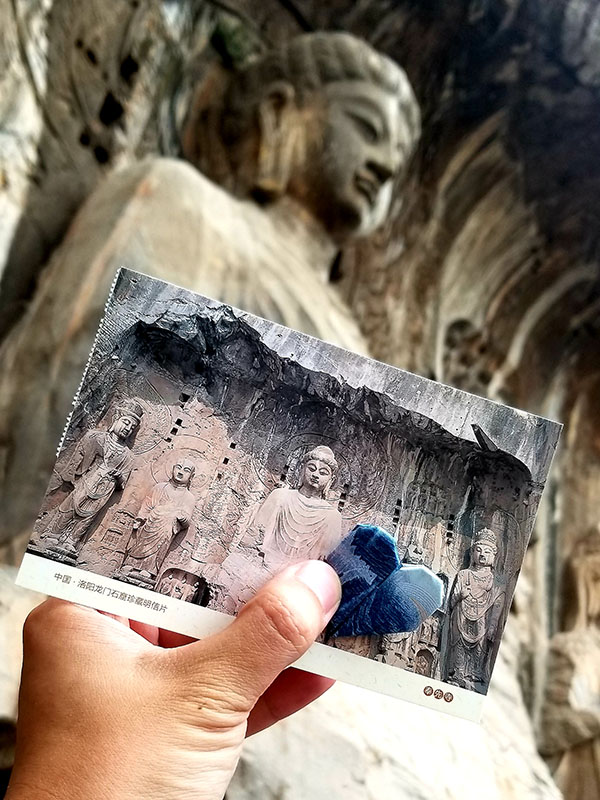 The site once again highlights the importance of education and I prayed for love, happiness and serenity for my family, friends, and all humankind. |
|
Kaifeng, Henan Province (河南省开封市) Kaifeng was the capital of China during several dynasties, and was visited by Marco Polo. As capital of the Northern Song dynasty from 1013 to 1127, Kaifeng was the largest and most prosperous city in China and the world. Yet the city was destroyed and abandoned during the Ming dynasty and most of the historical sites are buried 8m-12m underground due to numerous floods of the Yellow River.
|
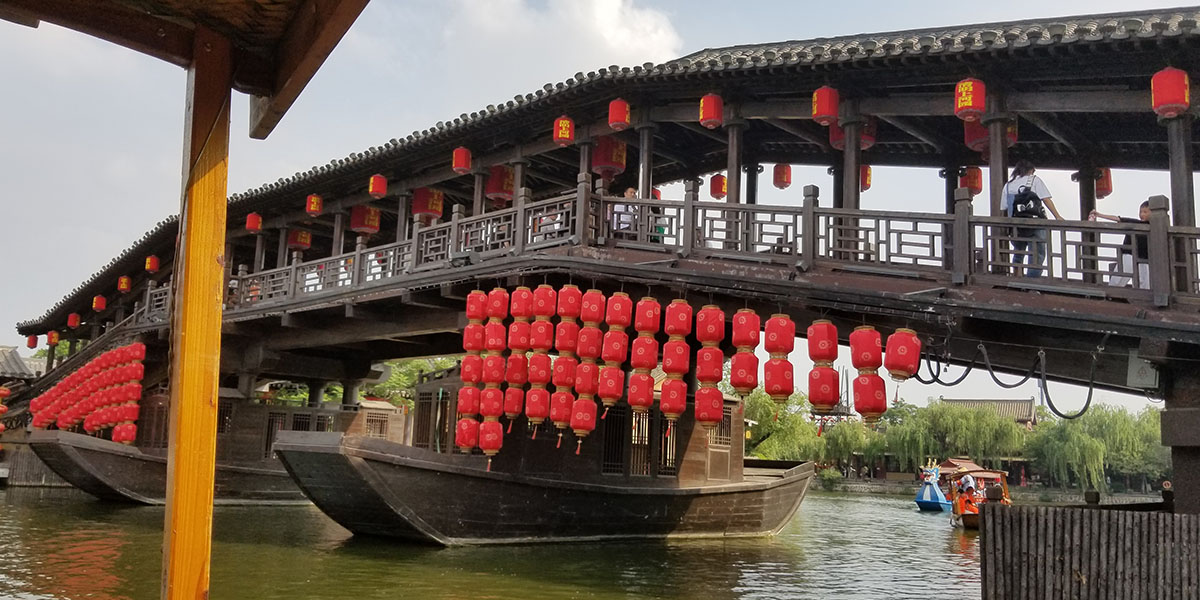 Qingming River Park (清明上河园) was recreated with landscaping, rivers, bridges, shops and buildings as displayed in the painting. |
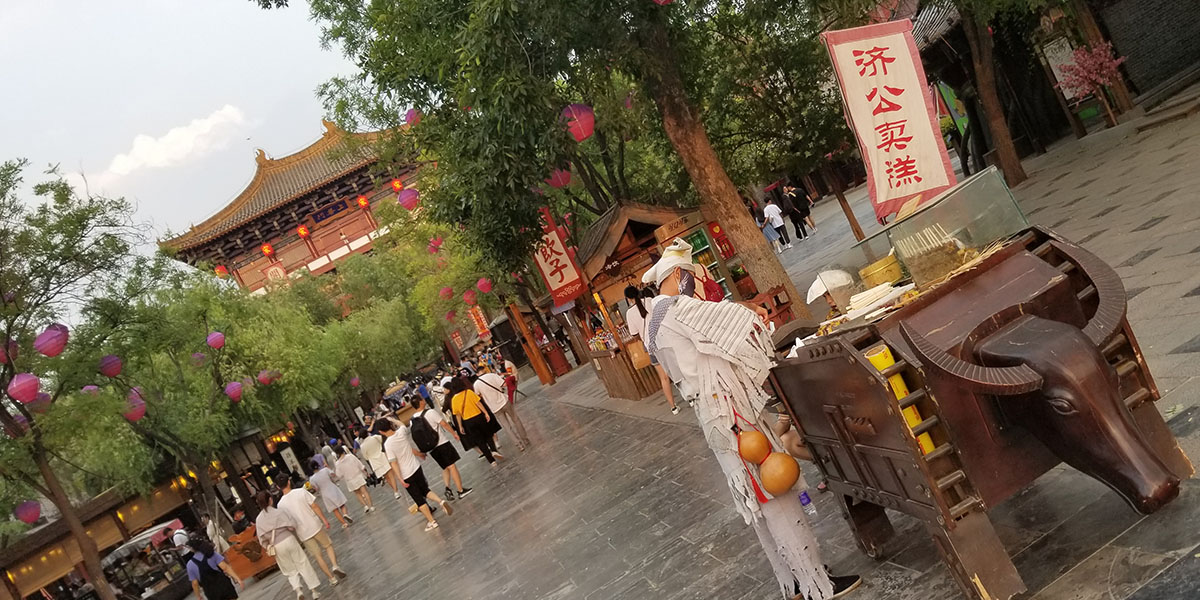 The park, which is subject for entrance fee, is full of shops and is very commercial, as it brings you back to the time capsule of the hustling market of the Song dynasty. |
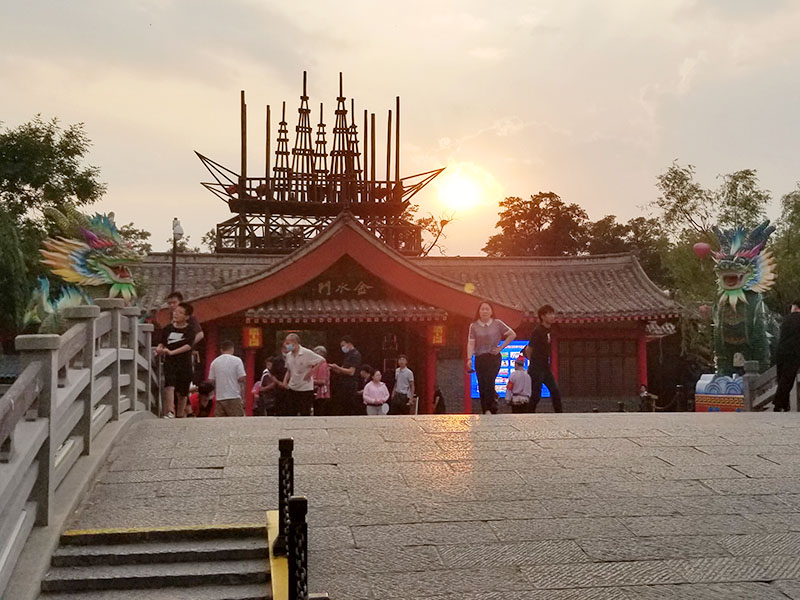 There are live performances at various location over the park from the morning to the late evening. |
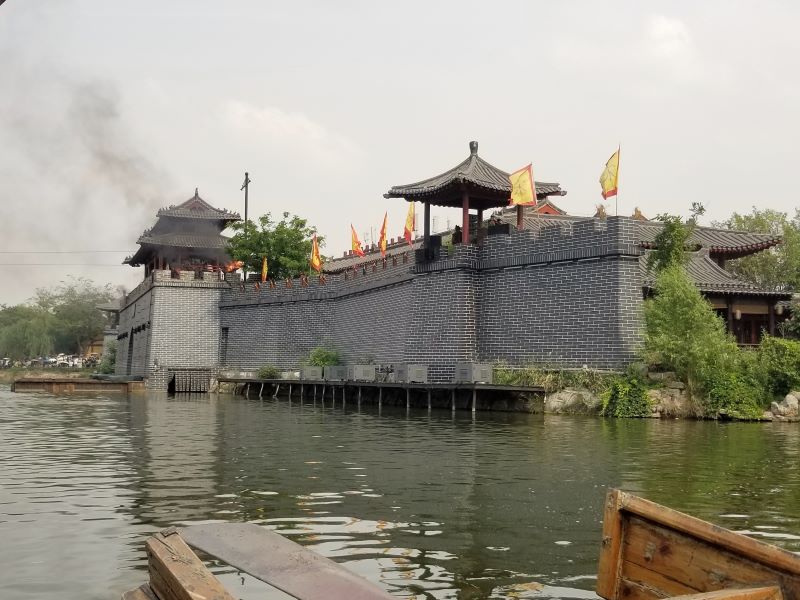 The battle for Kaifeng between the Song and Jin dynasties, performed with cannons, flames, ships, and martial arts. |
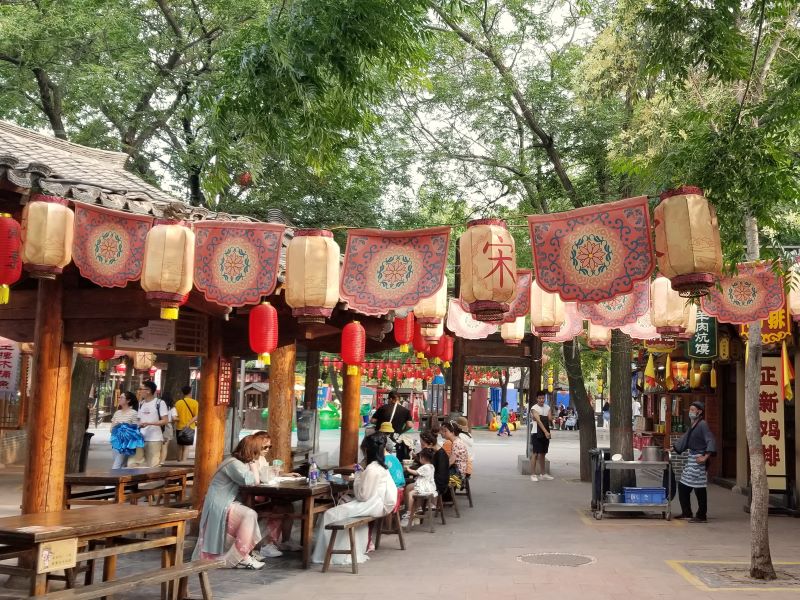 Visitors can borrow the Song costume for free and strol around the park. |
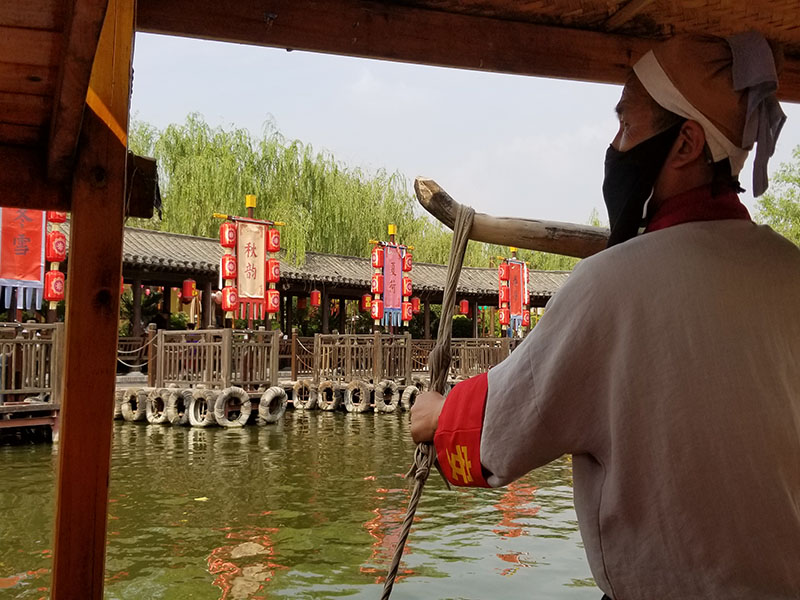 Boat rides can be hired for a relax journey touring the park under the shade. |
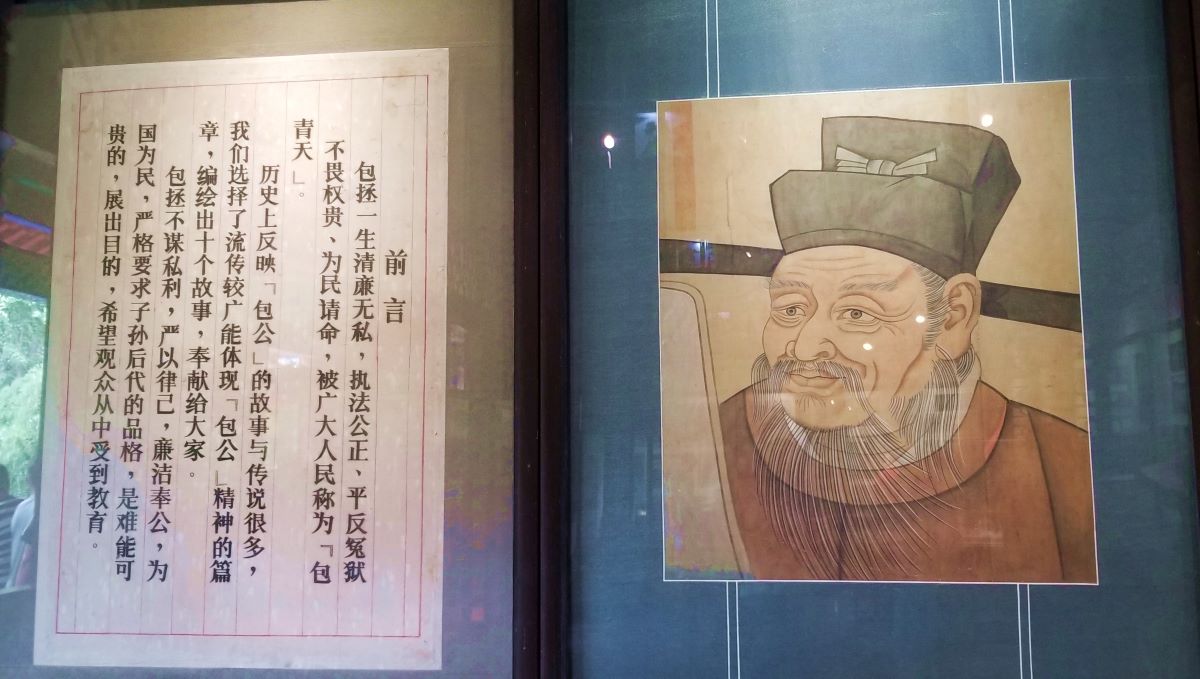 Lord Bao (包公), was a well-known incorruptible, honest and upright official in the North Song Dynasty (960–1127), who was famous for his fairness in lawsuits. He has been praised by generation after generation and many Chinese operas and dramas have adopted his stories. However, as governor of Kaifeng resumed office for only one year, so most of the stories from dramas are fiction, including the three famous blades to behead convicts, his dark skin and the moon on his forehead are all screen play creation. |
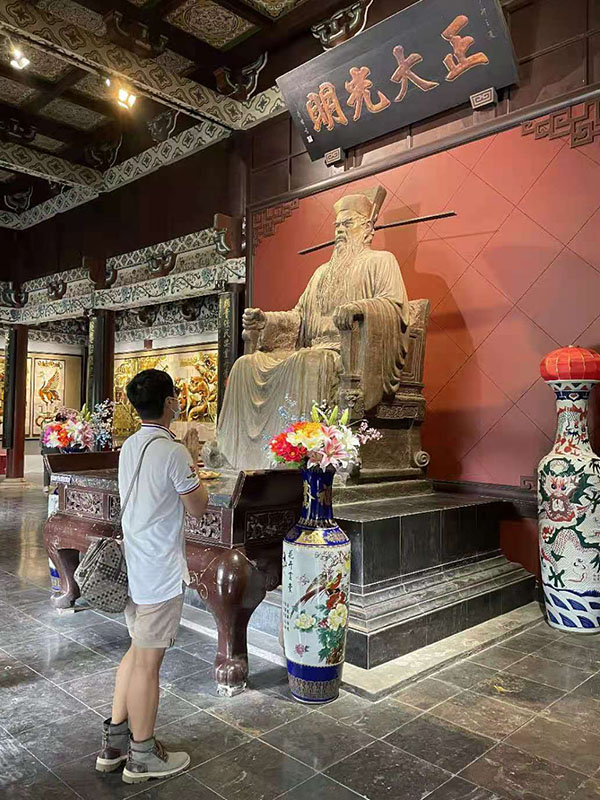 As Lord Bao represents fairness and righteousness, some people who encounter unfair treatments from everyday life could come in front of his statue here and pray for justice to unveil. Some may even cry as the unfairness were too heavy to stomach. |
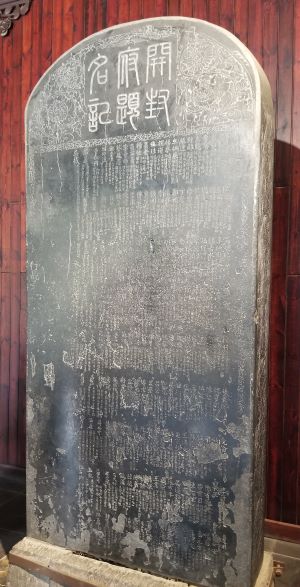 This Kaifeng monument lists out the 183 successive governors from 960. The deep depression under Lord Bao's name represents people's love and admiration of him. |
|
Dengfeng, Henan Province (河南省登封市) 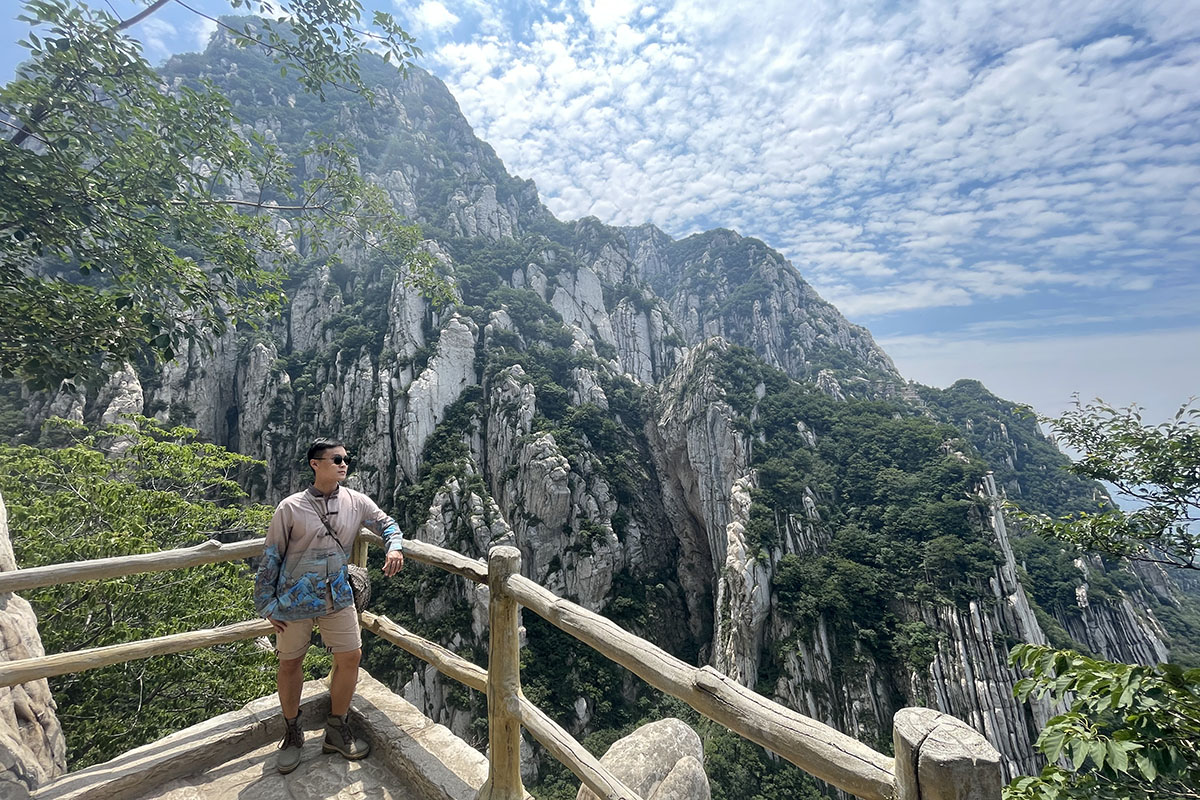 Mount Song (嵩山) occupied a prominent position among Chinese sacred mountains as early as the 1st century BC, when it was proclaimed one of the Five Holy Peaks (五岳) of China. |
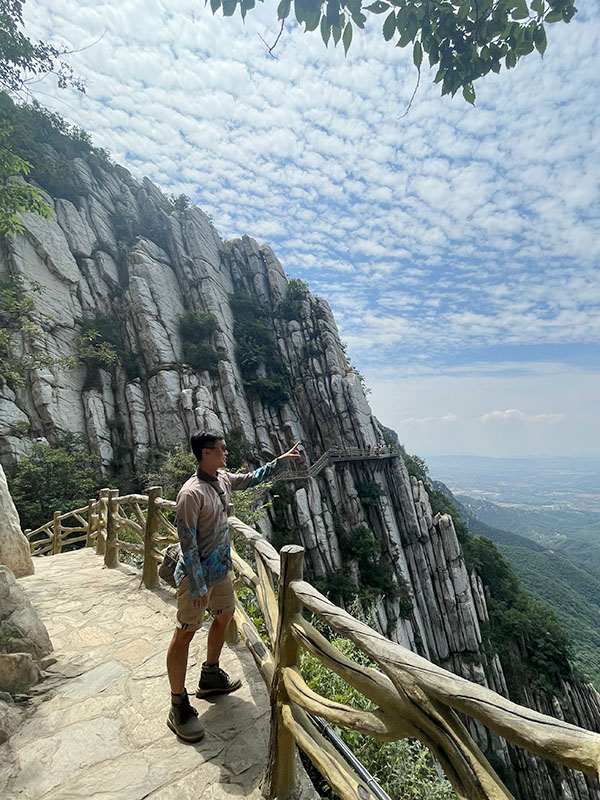 Shuce Cliff (书册崖), a landmark of Mount Song as it resembles books on the book shelf. |
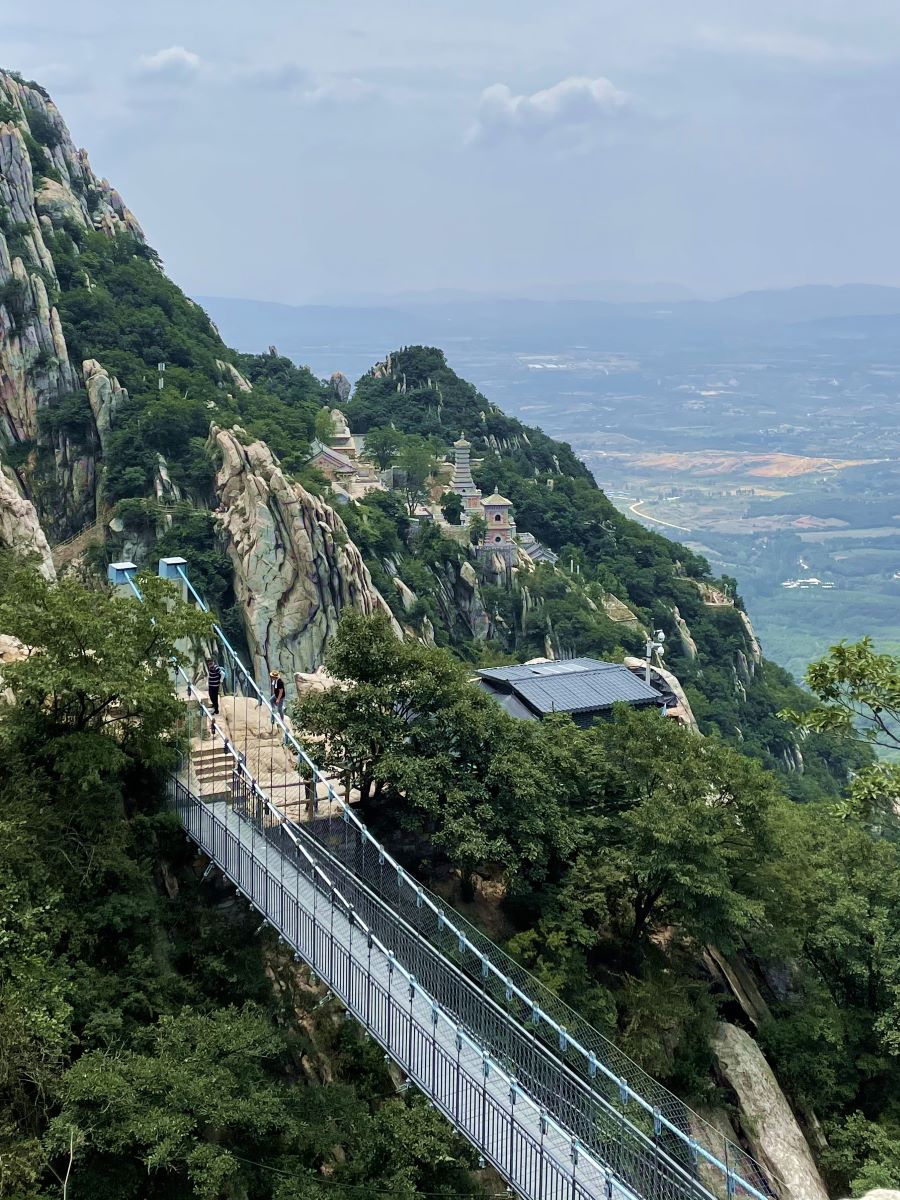 San Huang Zhai Monastery (三皇寨) is the Buddhist temple on the cliffs of Mount Song. |
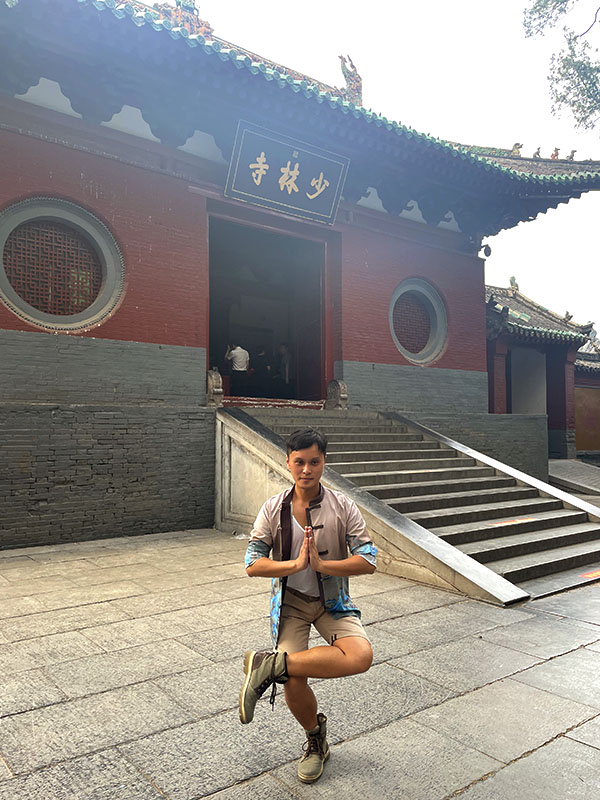 Shaolin Monastery (少林寺), is a renowned Chinese temple recognized as the birthplace of Zen Buddhism and Shaolin Kung Fu. This entrance gate of the monastery, Mount Gate (山门), installed a tablet of golden characters "Shaolin Temple" was written by the Great Emperor Kangxi of the Qing dynasty in 1704. |
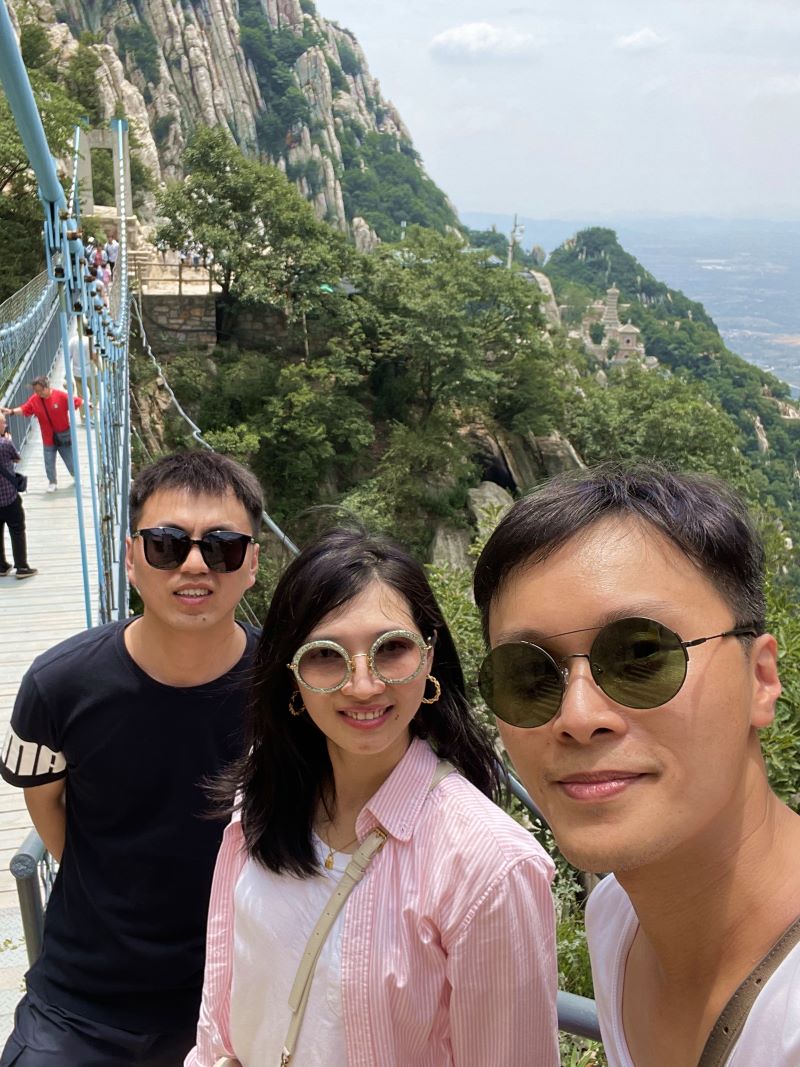 Thank Jiaheng for bringing Tanya and me touring various places in Henan including Mount Song and Shaolin Monastery, which locates at the foot of the mountain. Glad we took cable car to go up the peak which saved us 3 hours of hike, while walking from the cable car stop to San Huang Zhai Monastery requires 3 hours walk one way. |
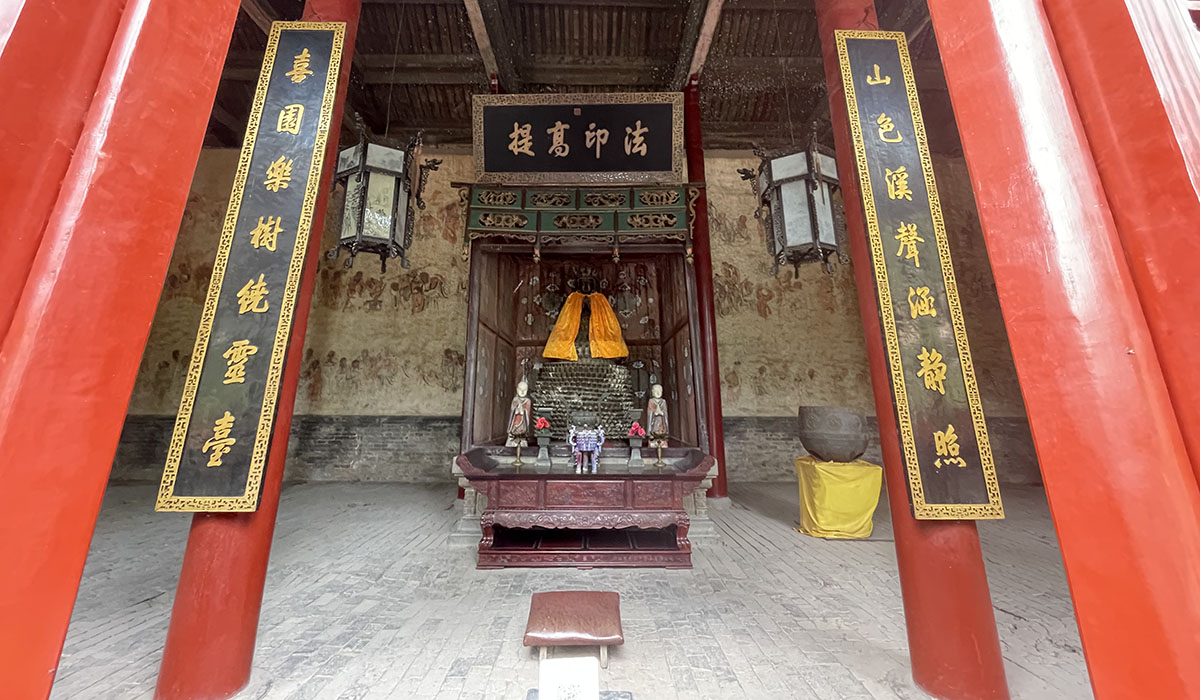 The Shaolin Temple was first established in 485. This Thousand Buddha Hall (千佛殿), built in 1588, is the back-most hall of Shaolin Temple. The sunken floor is the result of years of hard practice of Kong Fu by the monks. Only the senior martial art monks could practice in the hall. |
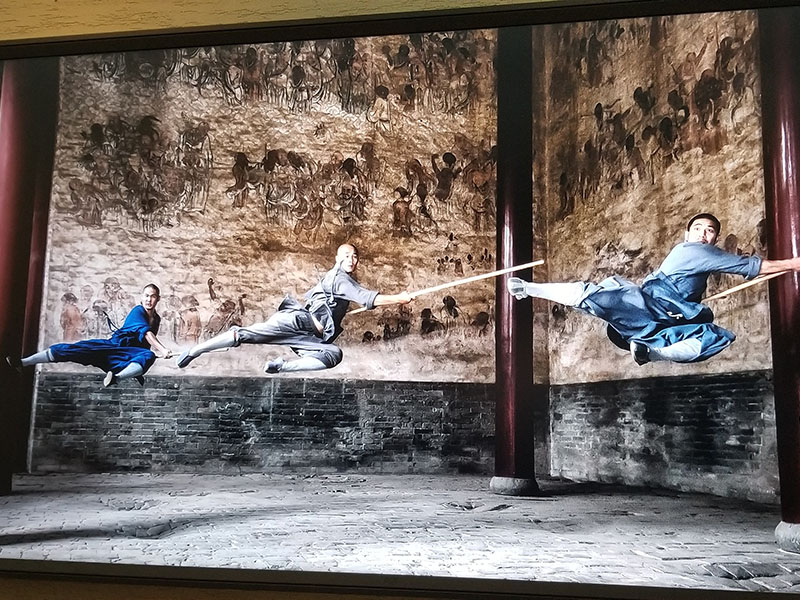 Gone are the days monks practiced in Shaolin and isolated mountain as the whole area have become a tourist location. Why would a true monk want to expose to noises of civilization... |
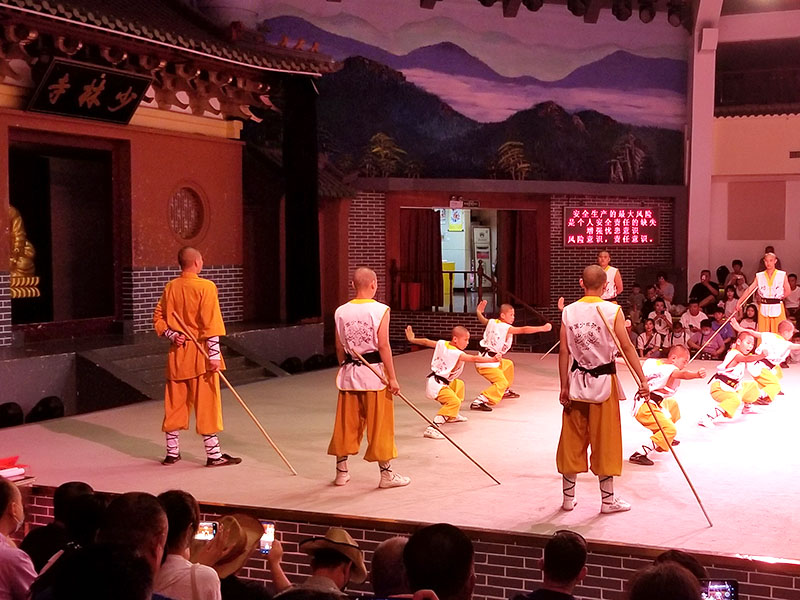 Today, Dengfeng City houses dozens of martial schools boarding over 100,000 students from all over China. Kung Fu performance is a big show here. |
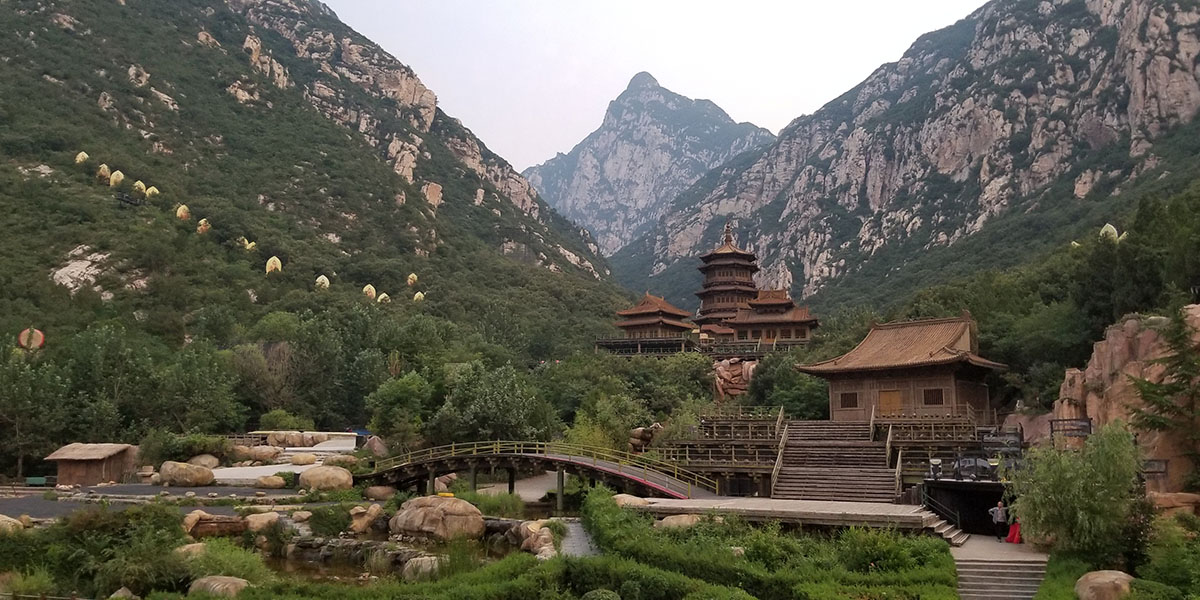 The main pillars of the Shaolin culture are Zen Buddhism (禅), martial arts (武), Buddhist art (艺), and traditional Chinese medicine (医). The Shaolin Zen Music Ritual (禅宗少林.音乐大典) tries to bring out these elements in an 1.5 hour music show. |
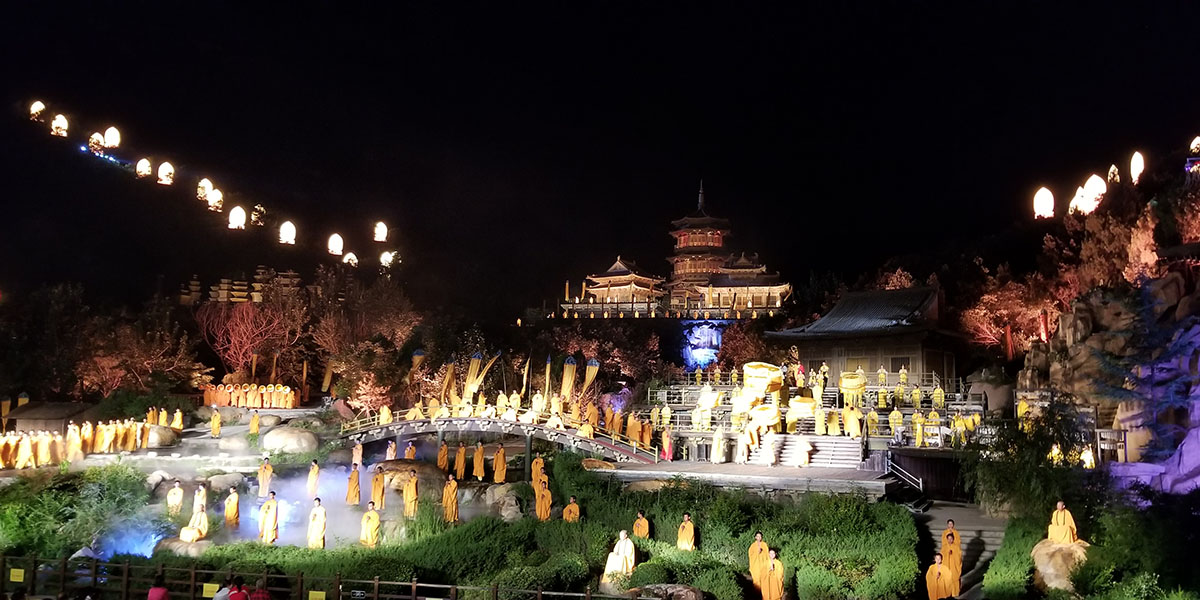 The show is performed by about 600 musicians, dancers, local villagers and Kung Fu monks with first class audio and visual effects that keep on thrilling audiences. It is costly, yet worth it. I do thank my client's treat for the show and excursion. |
|
Zhengzhou, Henan Province (河南省郑州市) |
|
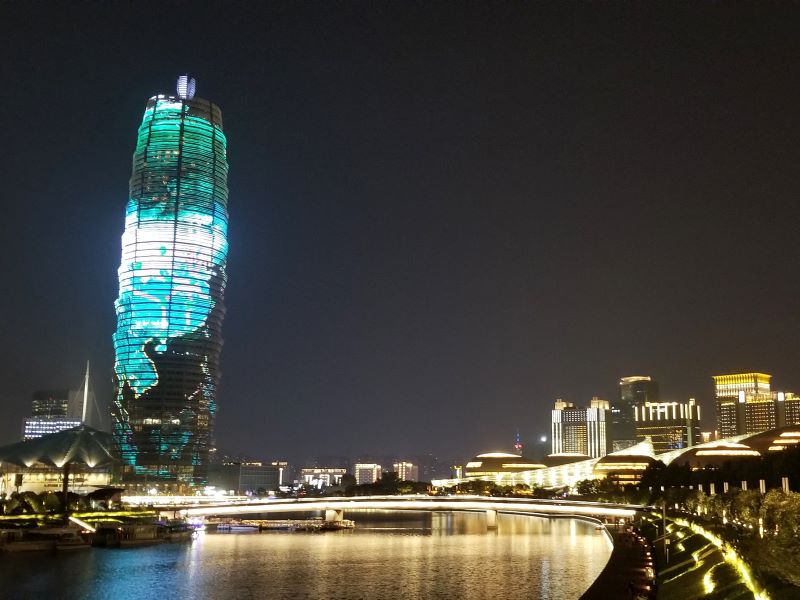 Zhengzhou is the capital of Henan Province. It is a redeveloped metropolitan city which was designed for administrative function and business activities. |
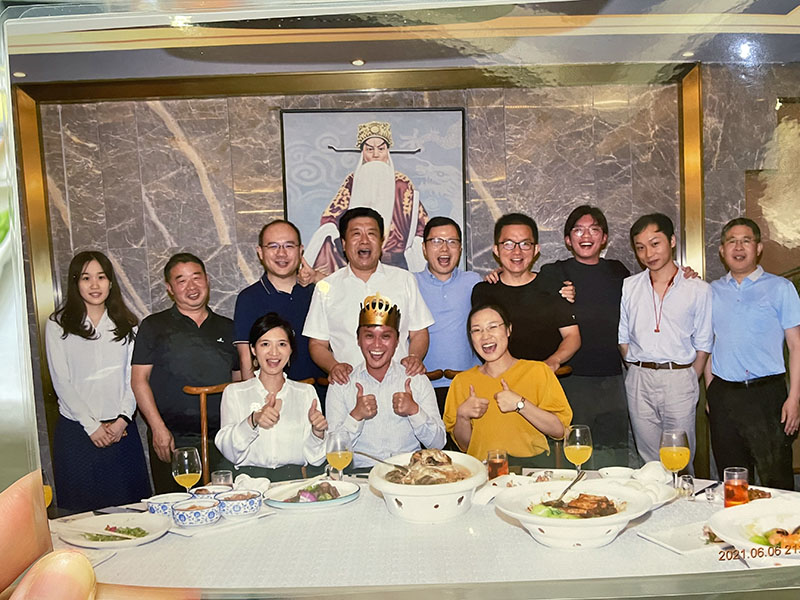 I arrived Zhengzhou on my birthday, and was fortunate to have my client and other professional parties to celebrate the birthday for me. Thankful. |
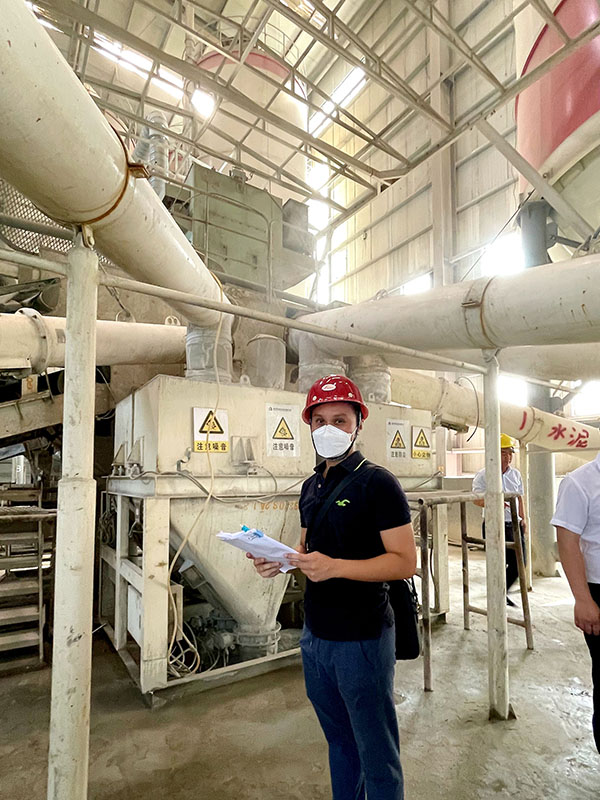 The project I am handling in Zhengzhou belongs to the ready-mixed concrete industry, so I had a chance to learn more about infrastructure and building construction, concrete, cement, mining and extraction. |
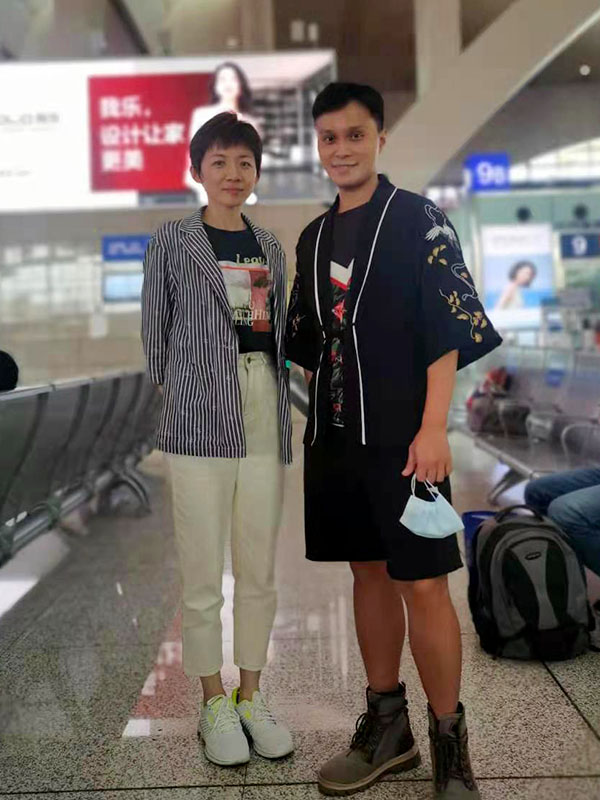 The first time meeting my pen friend, Lydia, of almost two decades. Glad we made it to arrange to meet at Shijiazhuang in a short period of time. Thank you for the company and memories. |
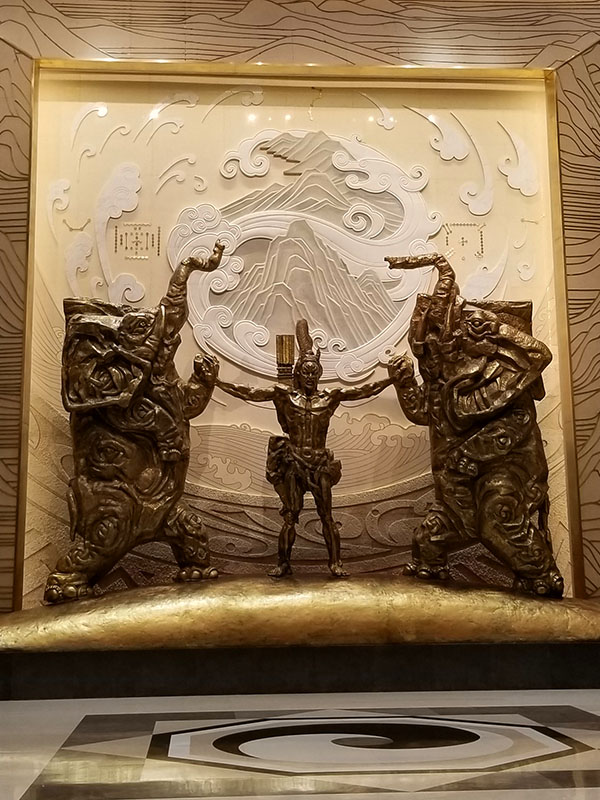 What's intriguing to me in the whole of Zhengzhou is the Henan Museum (河南博物院). It has a collection of 130,000+ pieces of cultural relics treasures, of which 5,000+ pieces are treasures of first and second grades. |
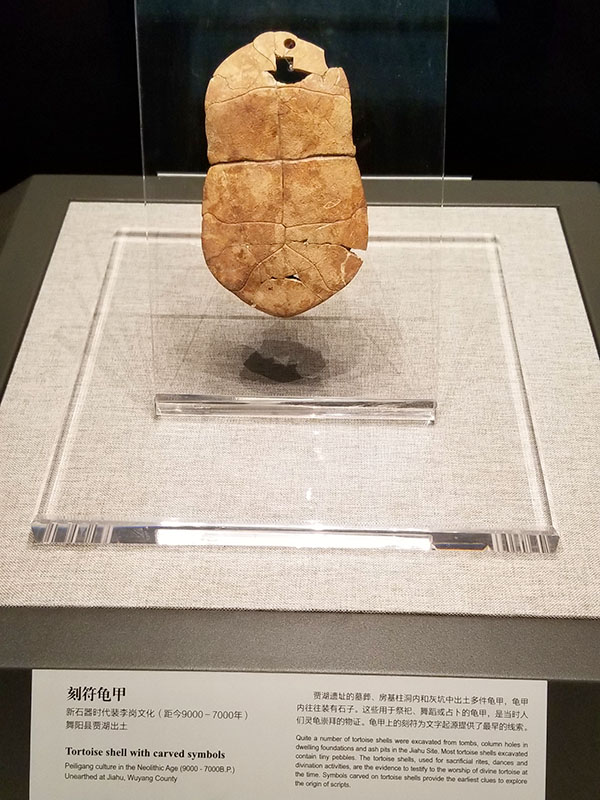 As Central China is the birth place of the Chinese civilization, so artefacts exhibited here have immense historic value. This turtle shell contains a carved symbol of the sun "日", dating to 6000 BC. Look at the right-down quadrant. |
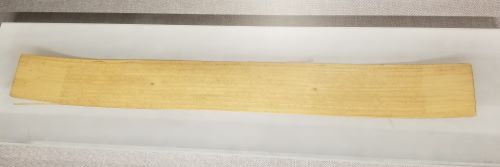 |
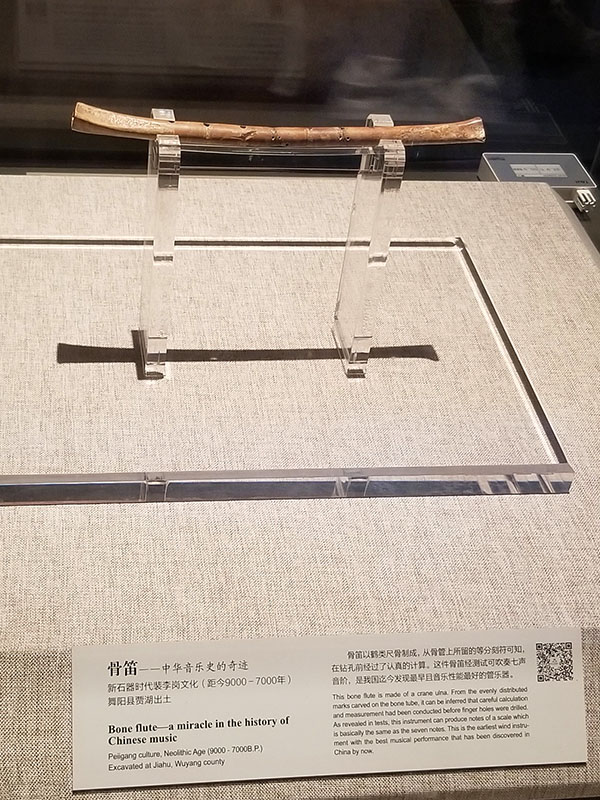 The Jiahu bone flute (贾湖骨笛) is the oldest known musical instrument from China, dated back to 6000 BC. It is made from the legs of the red-crowned crane. It is amazing to know early human were capable to perform and appreciate wind instrument music. |
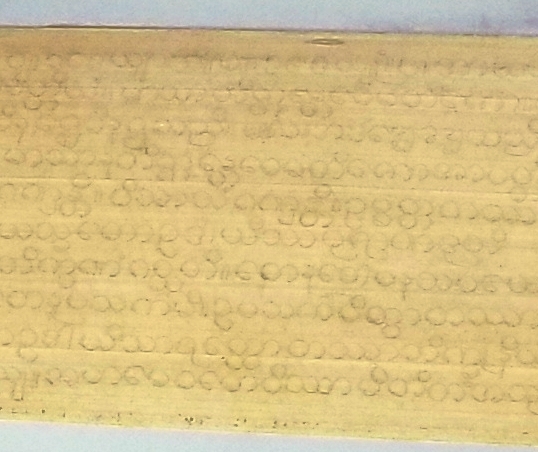 Pattra-leaf Sanskrit Buddhist manuscript (梵文贝叶佛经) obtained in Tang Dynasty - Sanskrit is the classic language of India while the manuscript wrote on the pattra-leaf, originated in ancient India, is likely from Buddhist classics, bearing extremely high values in cultural heritages. |
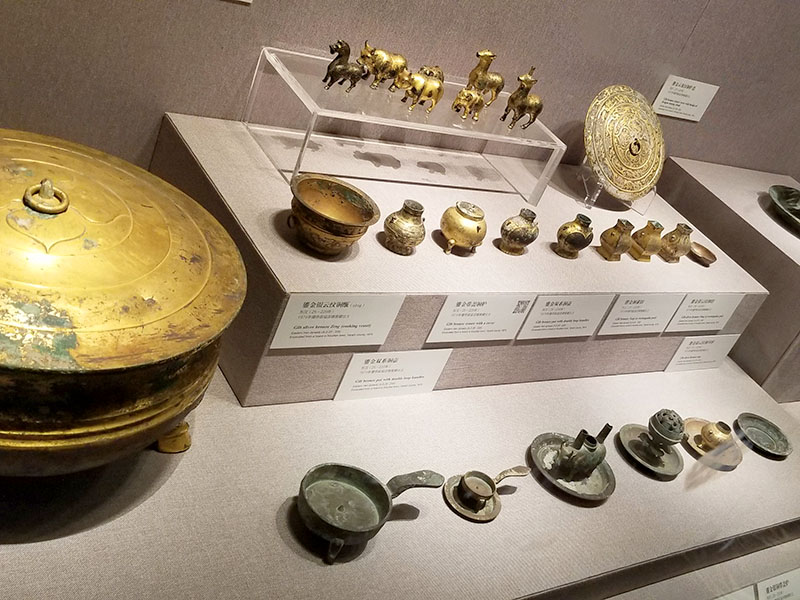 The Bronze Age in China, began around 2000 BC, witnessed the growth of a civilization and the establishment of social orders. In China, as in other societies, the mechanism that generated social cohesion was ritualization. As most of the paraphernalia for rituals were made in bronze, the forms, decorations and amount of bronze ware signified the prestige of the era. |
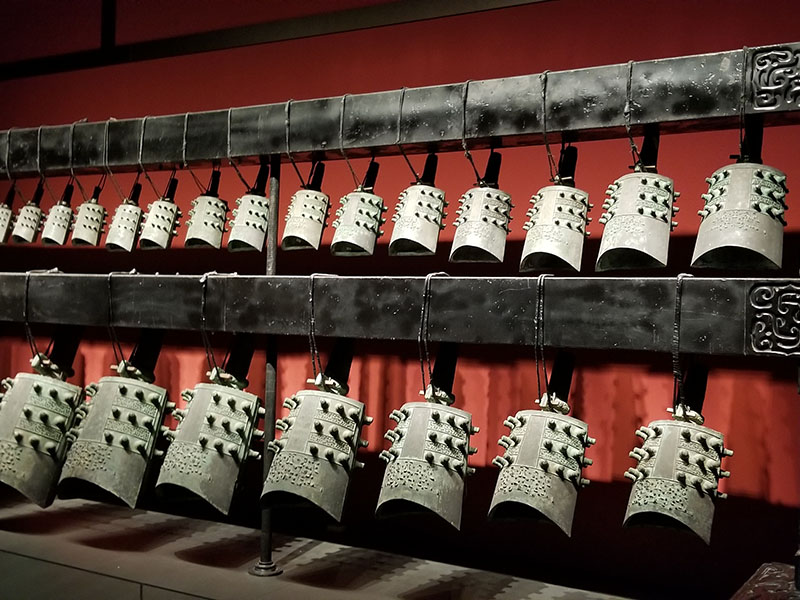 Bianzhong (编钟) or Chime Bells is an ancient Chinese musical instrument consisting of a set of bronze bells, played melodically. China is the earliest country to manufacture and use musical chimes. Some of these bells have been dated at between 2,000 to 3,600 years old. |
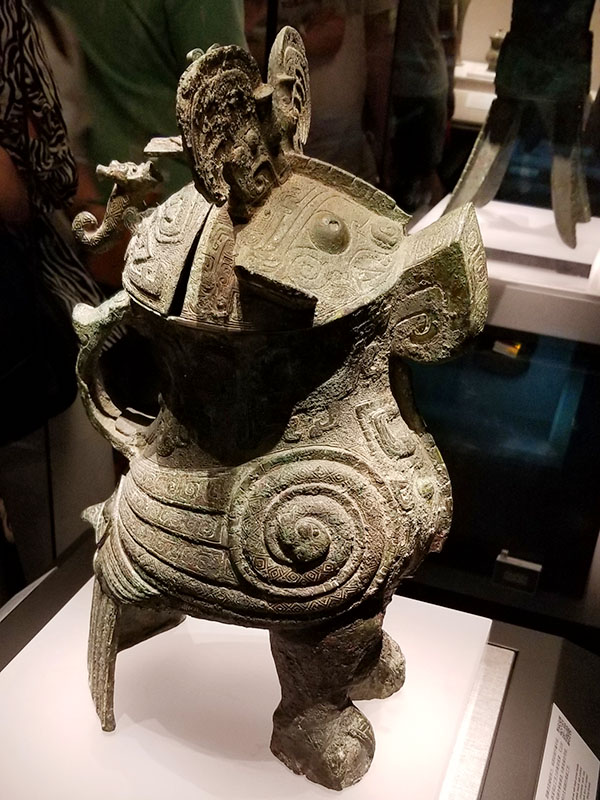 The Fuhao owl-shaped bronze zun (妇好鸮尊) (1300-1046 BC) is a cute animal-shaped wine vessel bearing the design of an owl with rich and delicate patterns. In the Shang Dynasty, owl was believed to hold mythical power. This particular owl-shaped vessel retains a solemn and powerful posture which is rare. |
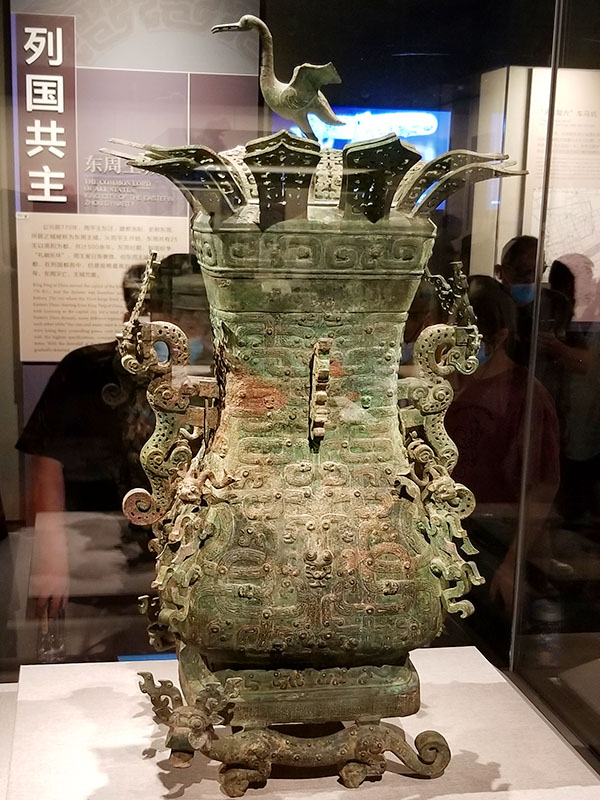 The square ewer with design of lotus and crane (春秋蓮鶴方壺) belonged to a King of the Zheng State. The crane posing at the top spreading its wings for take off was a sharp contrast to the traditionally decorated vessel body. It reflects a completely new artistic idea in late Spring and Autumn Period (770BC - 476BC). |
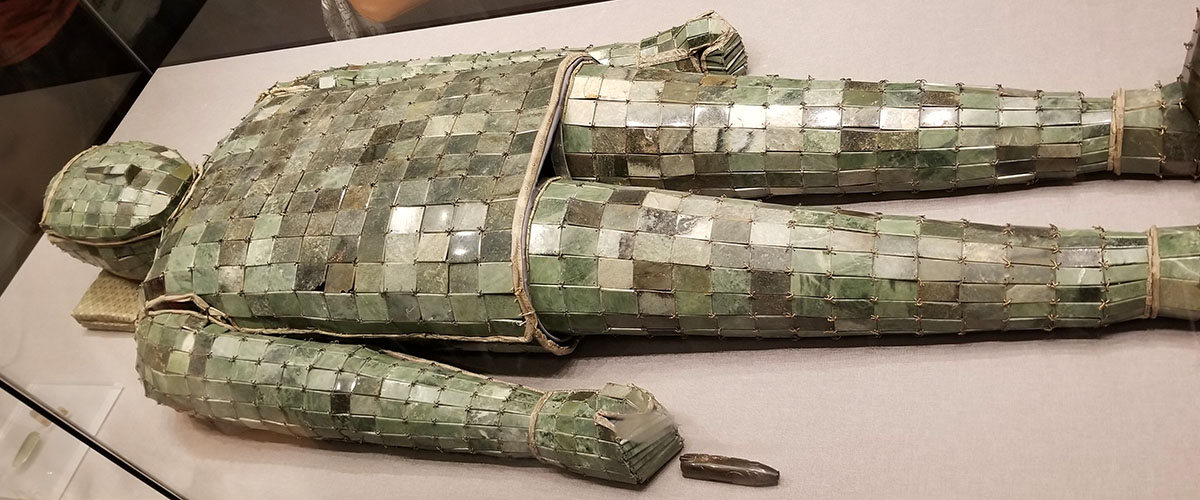 Jade suit (玉衣) was the burial clothes of emperors and high-ranking nobles of the Han Dynasty (206BC - 25AD). The suit was made up of 2008 pieces of jade sewn together with gold wire, silver wire or copper wire according to the nobility rank of the deceased. This jade suit was the burial suit of King Liang of the royal family of the Western Han Dynasty. |
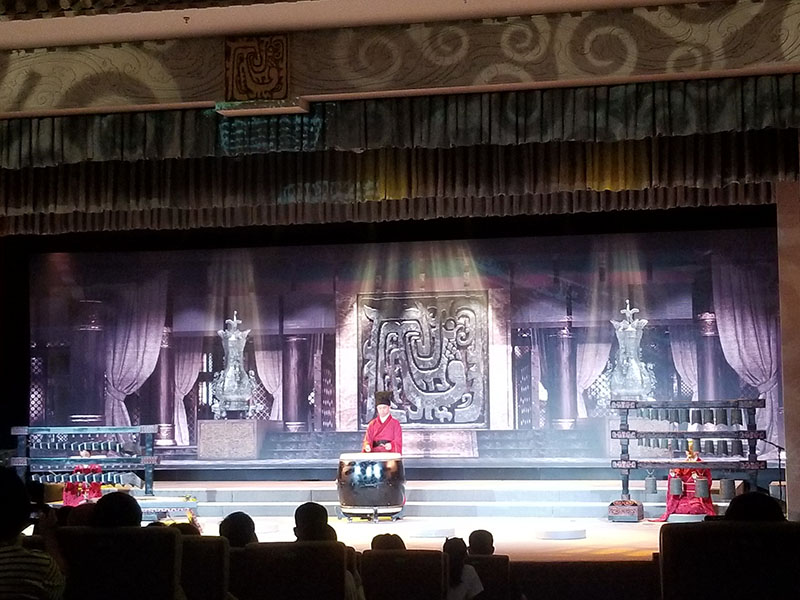 Henan Museum Huaxia Ancient Music Performance (河南博物院华夏古乐团) leads us to an acoustic journey to the ancient China with the musical instruments played from replicas of the actual which were unearthed from ancient tombs. |
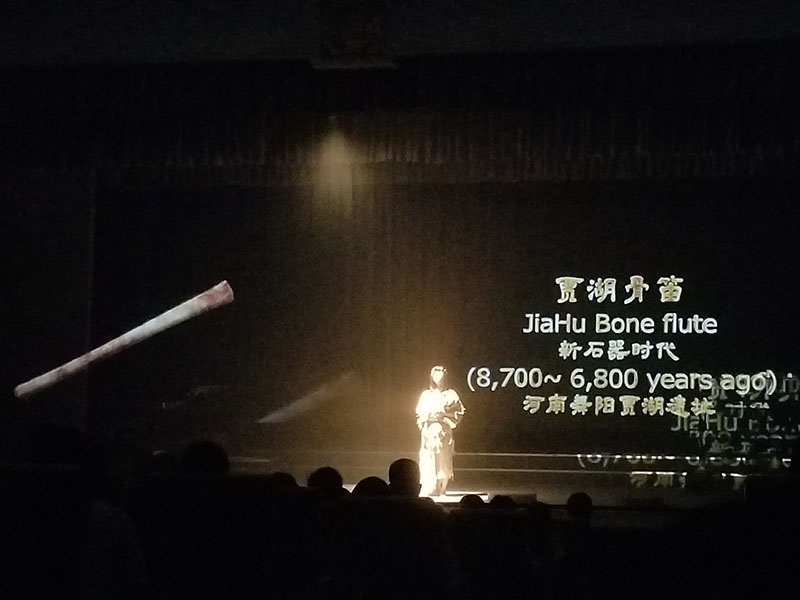 The music were composed by many experts according to ancient music score handed down to us. Listen to the music delivered by the oldest known musical instrument from China, Jiahu bone flute, would be like living in the moment. |
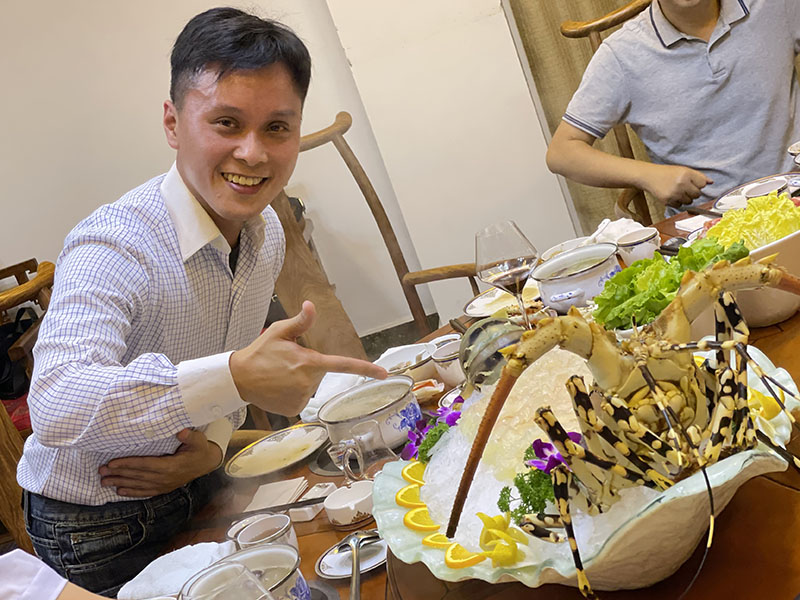 My client treated us quite some feasts over this month. From having puked on the first day, I was eventually trained to drink 200ml of Mao-tai in a meal on the last day. I also learned some drinking verses too: 激动的心,颤抖的手,就想跟你喝杯酒。杯中酒,酒中情,杯杯都是真感情。 |
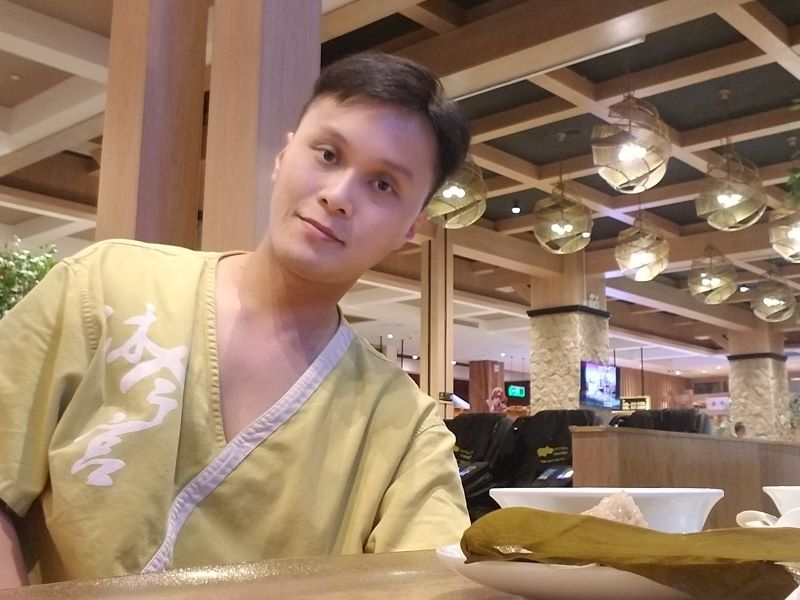 I explored a local bath and tried 躺澡 which I just laid flat naked on a bench and a master bathed, scrubbed and massaged my whole body. However as I am from a hot and humid climate and sweat frequently, my skin is tender and smooth; the scrub bath irritated my skin and rashes appeared. Well, I tried. |
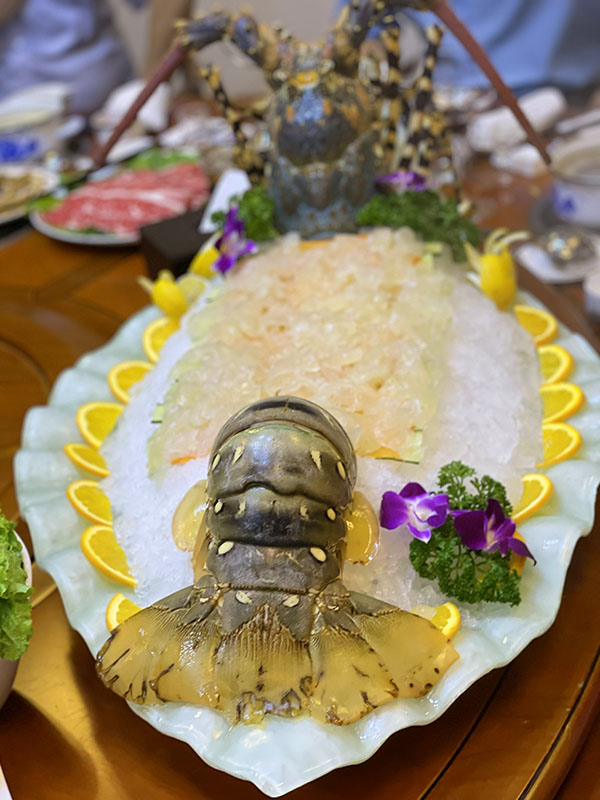 This lobster is 9kg and cost about RMB20,000-30,000. It was freshly flew from Hainan to Zhengzhou. |
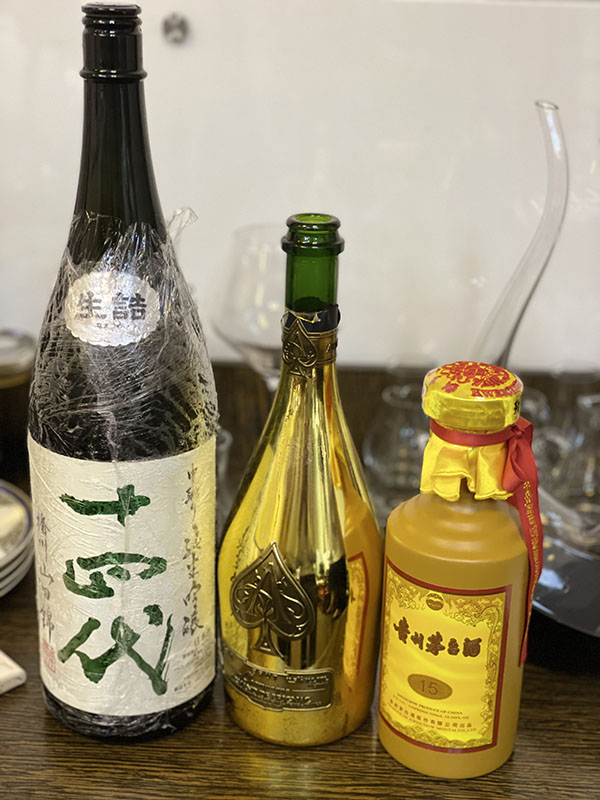 Every feast I had Mao-tai and on this day we had among the best (and expensive) sake, champagne and mao-tai. |
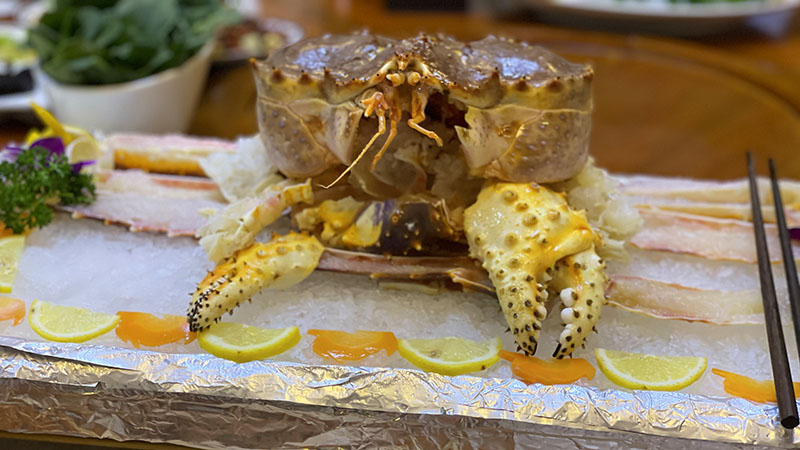 This crab is very tasty too. Thank God I didn't puke after the Henan style drinking (串酒), which everyone circles around the table to greet each other with a cup of alcohol, so every bite of the fresh meat went through my taste buds to the tummy. |
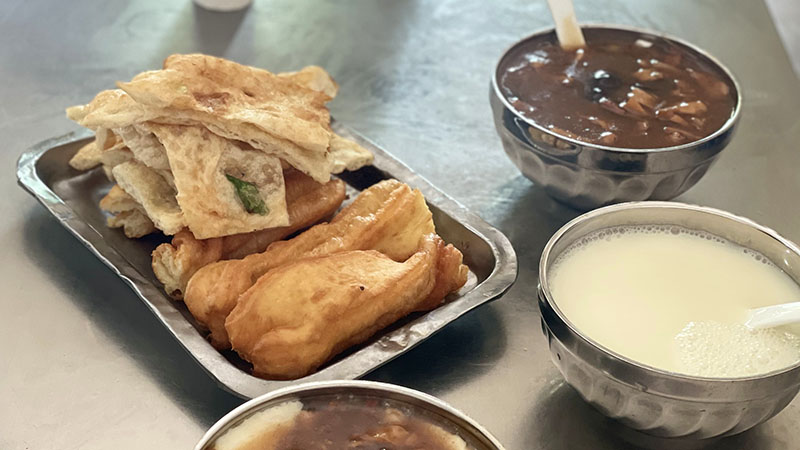 I also tried the local signature pepper and spice soup (胡辣汤) many times. I never had diarrhea through out the journey. The taste was unique which I brought the sauce pack back to Hong Kong. Yet no one wants to try with me... |
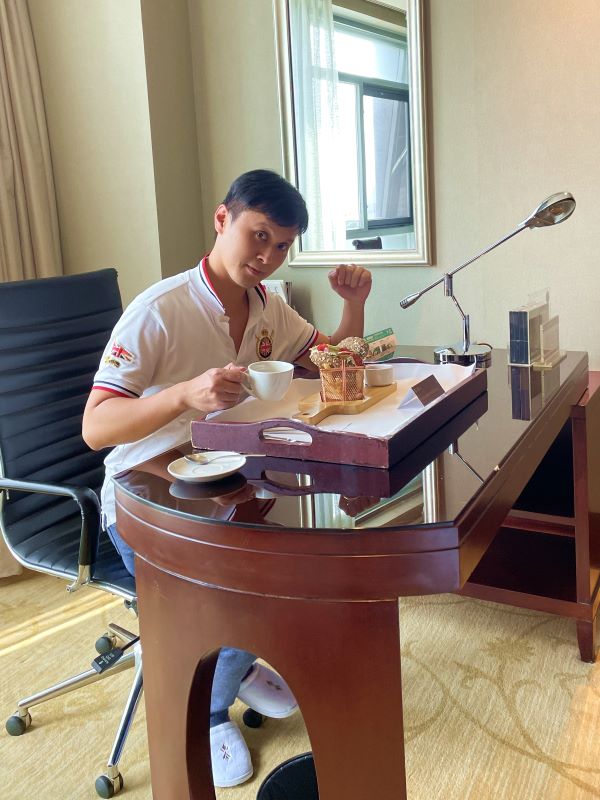 This is the 5-star hotel I stayed for 3 weeks with a proper gym training centre, a swimming pool, and in suite bath tub adjacent to floor to ceiling window. Only RMB550 a night. |
 While I had lunch and dinner in Chinese oily style, I opted for western breakfast every morning, especially with the cream and chocolate waffle. It's my Zhengzhou memory. |
|
|
|
|

